PinotFile: 8.17 June 21, 2010
|
Noiregon Excels in 2008The 2008 vintage in Oregon has been highly touted with some vintners claiming it is the best vintage for Oregon Pinot Noir in this decade, or even in Oregon’s modern 50+ year winegrowing history. I know that we have heard this shouting before from wineries, but based on the many 2008 Oregon Pinot Noirs I have sampled, this is no shallow hype. The vintage was not without its challenges. A perfect spring led to a huge crop, even two to three times normal if no thinning was performed. Rains arrived in September, creating the potential for mold. Warm weather followed the rains in September and into October, increasing the potential for high sugars and over ripe flavors. Vintners were able to pick at their leisure, and harvest extended all the way to Halloween. Those wineries that harvested grapes earlier before sugars rose brought in fresh fruit and the resulting wines are stellar. The 2008 Pinot Noirs are midway between the 2006 and 2007 vintages, with well-endowed, forward fruit typical of the 2006 Pinot Noirs, but less extracted than 2006, combined with the acidity and brightness of the 2007 Pinot Noirs. The alcohols are higher and the tannins more evident in 2008 than in 2007, but still moderate. Rating vintages is a gross generalization and highly variable depending on who does the rating. Robert Parker’s Wine Advocate rates the 2008 vintage in Oregon 92, the same as for the excellent 2002 and 1999 vintages. Wine Enthusiast thinks less of the vintage, rating it 88, less than Oregon’s 2006, 2004, 2000, 1999 and 1998 vintages. Wine Spectator was full of praise, giving the vintage a 95-100 rating, the highest ever for Oregon by this publication.
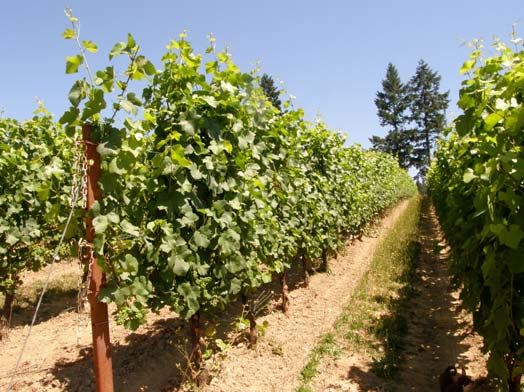 The 2008 Oregon Pinot Noirs provide potentially superb drinking pleasure, but the wines are generally closed and somewhat tannic upon release, lacking in up front accessibility. Winemaker Steve Lutz of Lenné Estate in the Yamhill-Carlton District told me, “They are still pretty tight but I am starting to get excited about them. I don’t think they will have much suppleness until we get into mid or late fall. It is a very restrained vintage for alcohol.” I have found most premium wines to be brooding and reticent upon opening, only to find them emerging several hours after opening, and displaying even more charm the next day. Preferably, the 2008 Pinot Noirs should be cellared at least a year and ideally longer than this. If you can’t resist popping the cork now, you must decant the wines. Drink the more forward 2007 vintage while you stock up and wait for the 2008 Oregon Pinot Noirs to find their footing.
Shea Wine Cellars
Mark Vlossak, St. Innocent Dick Shea’s magical plot of land produced stunning Pinot Noirs in the 2008 vintage. Bigger than their very good 2007 counterparts, with more color, tannin and lush fruit, the alcohol levels are in the 14s, less than in 2006, but more than 2007. Since 1996, Dick and Dierdre Shea have had their own label, Shea Wine Cellars, producing Pinot Noir and Chardonnay exclusively from estate fruit. The wines have been consistently top flight, but it has taken them many years to arrive at a consistent style that they now comfortably embrace. Their current winemaker, Drew Voit, who was formerly an assistant at Domaine Serene, is the right match. The 2008 vintage is the first that Drew vinified completely at Shea Wine Cellars. The Sheas first planted their 200-acre property seven miles outside of Newberg on Highway 240 in 1989. At the time, they were living in Connecticut and Dick worked on Wall Street. He had been looking at a more ideal locality to raise his family and found Portland, Oregon to his liking. It was a bottle of 1986 Adelsheim Elizabeth’s Reserve Willamette Valley Pinot Noir that really piqued his interest in wine. In 1989, much of the focus in the Willamette Valley was on the Dundee Hills, but after much research, he chose an undeveloped area, Yamhill- Carlton, which eventually became famous for Pinot Noir.
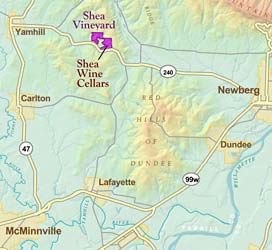 When asked about the secret of his success, Dick told me, “What I did right was putting plenty of effort into finding good people to advise and later work for me. I have picked up my knowledge from them.” One of these people was viticulturist Javier Marin, who has managed the vineyard from the beginning. Today, Shea Vineyard consists of 135 acres of Pinot Noir and 5 acres of Chardonnay planted on sedimentary yellow-red silty clay loam soil over fractured sandstone (so-called Willakenzie soil - see below). This soil is typically found in the foothills around Carlton, Yamhill and the Coast Range. Vine spacing is 5’ x 7’ totaling 1,245 plants per acre. Pinot Noir clones include Pommard, Wädenswil, and the newer Dijon clones, 114, 115, 777 and 828. Shea Vineyard has had the highest ranking for sustainable farming by the US Department of Agriculture Conservation Security Program since 2005. The original plantings of Pommard and Wädenswil clones were on their own roots and inevitably, phylloxera afflicted the vines. Planned replanting has been carried out through the years. 2008 was the last vintage for Block 22 own-rooted Pommard fruit, and the grapes were bottled as a separate wine, labeled “Last Hurrah.”
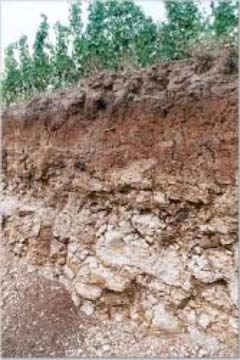 There are several features of the 2008 Shea Wine Cellars Pinot Noirs that are impressive. The wines are polished and harmonious, incorporating moderately high alcohols with sublimely silky textures and perfect integration of oak. In addition, the wines bring out the “Sheaness” that many tasters find expressed in this vineyard: a beautiful floral aroma, a spicy dark red and black fruit character, and a complimentary earthiness, all features that seem unusually clear and unique to this vineyard. Voit has managed to corral the vineyard’s propensity for fruit intensity, lift the elegance of the wines, soften the mouth feel, expose the nuances, and allow the terroir of the Shea Vineyard to show its best side. In three words: he nailed it. 2008 also heralds the introduction of block designations for all the Shea Wine Cellars Pinot Noirs except the Estate and the “Homer” reserve bottling. For those of you who have been frustrated with the various designations of past vintages (the vineyard is divided into two portions known as West Hill and East Hill, and contains 22 blocks with both numbered and named labels), this new labeling will be a welcome change.
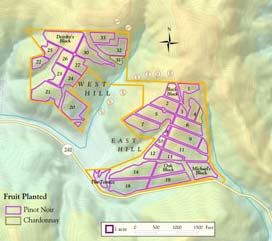 The 2008 Shea Wine Cellars Pinot Noirs offer an opportunity to taste the different clones from Shea Vineyard: the Block 5 bottling contains Dijon clone 777 from the East Hill, the Block 7 wine is 100% Wädenswil clone from the East Hill, the Block 22 wine is 100% own-rooted Pommard clone from the West Hill, and the Block 31 bottling of a blend of 70% Pommard and 30% Wädenswil clones from the West Hill. About 25% of grape production from Shea Vineyard is held back for the Shea Wine Cells label, with 75% going to multiple prestigious Pinot Noir producers in the Willamette Valley and Sta. Rita Hills of California. Total production is about 4200 cases annually and is sold primarily through a mailing list with limited retail distribution (primarily the larger production Estate bottling). Visit the website at www.sheawinecellars.com for more information and to join the mailing list. The vineyard and winery is not open to the public except during the traditional Willamette Valley Open House weekends (Memorial Day and Thanksgiving). At Shea Vineyard winery with left to right, Drew Voit, Dick Shea, and Diedre Shea (below).
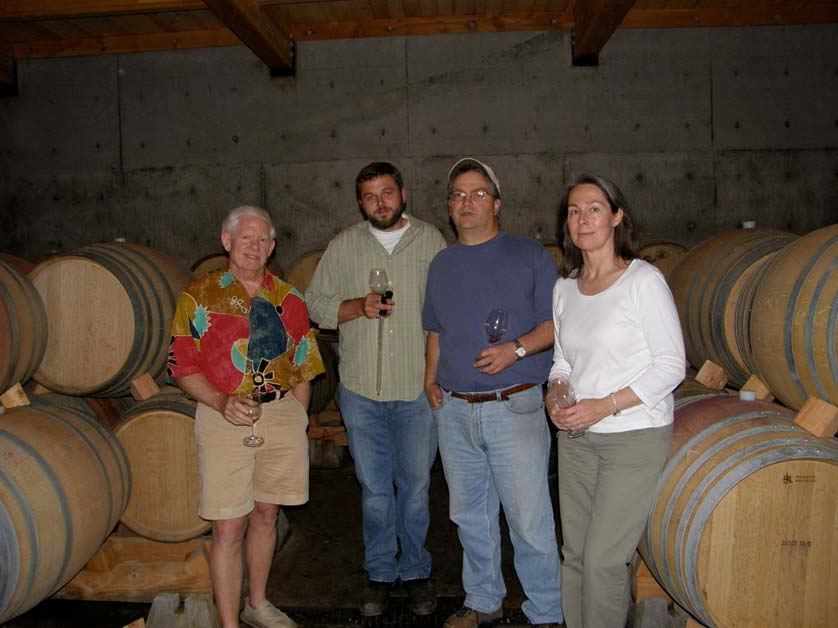
2008 Shea Wine Cellars Shea Vineyard Estate Pinot Noir 14.2% alc., $40. A blend that expresses the overall vineyard containing every clone including Pommard, Wädenswil and several Dijon clones. · Moderately dark robe in the glass. The nose is flush with nuanced aromas including black cherries, ripe strawberries, red licorice, violets, subtle oak, and a few scents I can’t describe. The wine kept pumping out these lovely aromas for over an hour in the glass. In the mouth, there are pretty flavors of dark red and nicely spiced stone fruits and berries, and the best grape soda you ever had. Moderately rich, with fine grain tannins, a satiny mouth feel and a pleasing lift of acidity on the finish. This is a nicely composed and elegant wine that is the best ever Estate bottling from Shea Wine Cellars. Very good
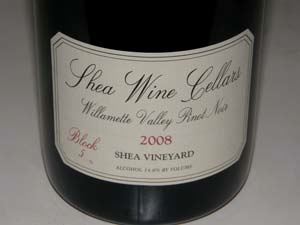 2008 Shea Wine Cellars Shea Vineyard Block 22 “Last Hurrah” Pinot Noir 13.7% alc., $55. This wine is the last from own rooted Pommard fruit. These vines were replanted after the 2008 harvest. · Moderately dark reddish-purple hue in the glass. Demure but pleasing aromas of fresh red berries, graham and violets. Delicious core of red and blue berries and cherries. Beautifully composed, with vivid and well-focused flavors, fine ground gossamer tannins, a velvety texture, and an amazingly long and aromatic finish that is flat-out stunning. A wine to treasure that is the last of its kind from Shea Vineyard. Drink some history.
2008 Shea Wine Cellars Shea Vineyard Block 31 Pinot Noir 14.8% alc., $55. 70% Pommard and 30% Wädenswil clones from the West Hill portion of Shea Vineyard. Aged in 57% new French oak barrels. · Moderately dark reddish-purple color in the glass. The nose is pleasantly fruity featuring dark stone fruits and berries but is very shy. Tasty core of dark berries, black cherries, and plums with a sidecar of spice and tea. The tannins are fine grain making the wine smooth and easygoing. Improves with time in the glass, but is still closed down at this stage and not yet offering as much as it will. Very good.
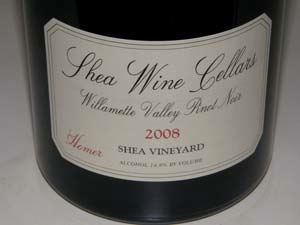 2008 Shea Wine Cellars Shea Vineyard Block 5 Pinot Noir 14.8% alc., $55. 100% clone 777 fromthe East Hill portion of Shea Vineyard. · Moderately dark reddish-purple color in the glass. You can really cozy up to this wine. Lovely perfume of blackberry jam, spice, mocha and that floral Sheaness. Like greased lightning on the palate with a delicious red and black berry core including alpine strawberries and red plums. Very harmonious with ripe, firm tannins and a generous, slightly warm finish that sails along. Even better the next day from a previously opened and re-corked bottle. I am not usually a fan of single Dijon clone Pinot Noirs, but it definitely works here.
2008 Shea Wine Cellars Shea Vineyard Block 7 Pinot Noir 14.8% alc., <275 cases, $55. All Wädenswil clone from the East Hill. Aged in 73% new French oak barrels. · Moderately reddish-purple robe. Subdued dark fruit aromas with a hint of spiced tea and oak toast. Picks up interest with time in the glass. Plush black raspberry and plum fruit with a touch of mocha java. Dark and enticing like an exotic woman in a black dress. Very smooth in the mouth, yet has a substantial structure and needs time to shed some tannins. A bit linear at this point, but there is enough sensuality now that it is hard to resist. Very good.
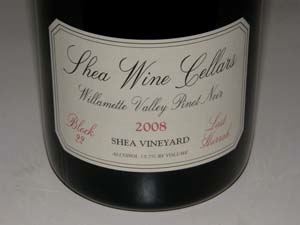 2008 Shea Wine Cellars Shea Vineyard “Homer” Pinot Noir 14.8% alc., $80. Sourced from the 14 best barrels in the cellar and includes Pommard, Wädenswil and Dijon clones. Aged in 93% new French oak barrels. · A shade darker than the other Pinot Noirs in 2008. Extremely reticent nose revealing some appealing oak-kissed dark fruit. Very well endowed with a lovely essence of purple fruits. Tight and monolithic now with a smokiness and cigar box note from the oak which needs time to integrate. Very smooth and sensual on the palate. I usually rate wines on their appeal at the time of tasting, but I need to make an exception here since I believe this will be a prodigious wine several years down the road based on other aged Homer bottlings I have had through the years.
Laura Volkman VineyardsIn many spousal winery ventures, the husband is the principal winegrower and winemaker, and the wife manages the business and markets the wines. At Laura Volkman Vineyards, it is just the opposite, with Laura acting as the driving force who makes all the winegrowing decisions, performs most of the physical work in the vineyard, crafts and bottles the wines, and sells the wines. For the most part, she will not allow anyone else, much less her husband, Jim, touch the vines. Jim says, “She takes every bottle personally,” while she likens her passion to a writer composing a great book who seeks a sequestered location to focus completely on the job at hand. She says with emphasis, “I have blinders on from April until the end of crush.” For a petite woman, you have to admire her gumption. Jim has his own profession, offering support and a helping hand only when needed.
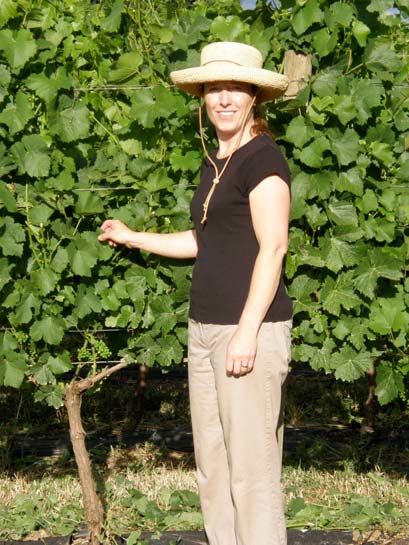 The Volkmans bought a small farm several years ago in Newberg, Oregon, part of the Chehalem Mountains AVA. They cleared the land and planted their 3.5-acre Elle Rêve Vineyard to Pinot Noir in 2002. The vines are primarily Dijon 115, with lesser amounts of 114, 667, 777 and Pommard. Laura’s winemaking is traditional and meticulous. Working at nearby August Cellars, a cooperative facility in which several winemakers lease space, she keeps fermentations cool to preserve the delicate aromas of Pinot Noir. She uses various yeasts and ferments each clone separately to create distinctive flavor profiles that set apart her two major Pinot Noir bottlings named after her daughter (Rachel Estate) and son (Jacob Estate). Absolutely no pumping is done. Aging is carried out in approximately 50% new French oak barrels. Once the wine has been raised, it goes directly to tank for blending and then straight to bottle by way of gravity flow. All her Pinot Noirs are unfined and unfiltered. Of the many grape varieties, Pinot Noir is the most temperamental, a fickle prodigy that can be brought to perform brilliantly only through meticulous parenting in the vineyard and in the winery. This explains why some of the world’s greatest Pinot Noirs come from very small producers who can personally nurse the frivolous grape every step of the way. Laura Volkman personifies this ideal and her wines show the result. Laura recommends that consumers wait a year after release to insure full integration and enjoyment of her Pinot Noirs. This is particularly crucial with the 2008 vintage wines. I previously tasted the 2008 Laura Volkman Vineyards Pinot Noir clonal wines from new oak barrels which eventually were blended with clonal wines from neutral barrels when bottled. She reported that yields had slightly decreased in 2008. The wines were darkly colored due to the prolonged summer heat. She described the wines as “big and lush with plenty of good (astringent) tannins with alcohols in the 13.5% range.” I was impressed with the barrel samples then and even more taken by the finished wines. All of her wines are medium-weighted with silky textures, impeccable harmony and display that elusive sensuality that pinotphiles worship. The lower alcohols and age ability of these wines (the Rachel and Jacob both drank better the next day from a previously opened and re-corked bottle) add a special bonus. The 2007 Pinot Noirs are drinking beautifully now but will not age as well as the 2008 vintage wines. The Rachel Estate tends to be a more shapely wine and the Jacob Estate is slightly more muscled.
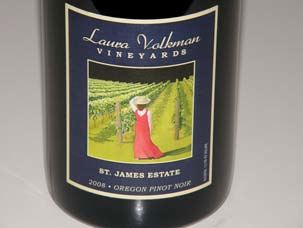 2008 Laura Volkman St. James Estate Willamette Valley Pinot Noir 13.5% alc., $25. Named after Laura’s husband, Jim. A blend of all blocks in the vineyard. · Scents of black cherries, allspice, pine pitch and the faintest oak. Moderately generous flavors of cherries, berries and red licorice. Soft in the mouth with supple tannins. A short-term easygoing wine at a fair price. Good.
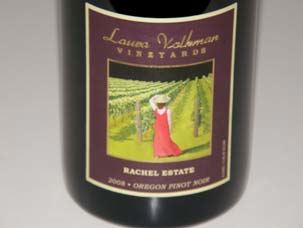 2008 Laura Volkman Rachel Estate Willamette Valley Pinot Noir 13.5% alc., $40. From the West Block of the estate vineyard including Pommard and Dijon clones 667 and 114. Aged on the lees in 50% new French oak. · Moderate reddish-purple hue in the glass. Very charming scents of plum sauce, mixed berry tart and spice box that led me to write, “You gotta be kidding me!” The attack of dark red cherries and berries is ripe, juicy and vivid augmented by flavors of cherry skins and savory herbs. Slightly more weight than the 2007 version of this wine but not weighty. Finely tuned tannins and impeccable balance. The cherry aromas linger on the finish for more than 30 seconds. This is the kind of Pinot Noir that drives normal people to do almost anything to get their hands on some. Very approachable now, but built to last another 7 to 10 years.
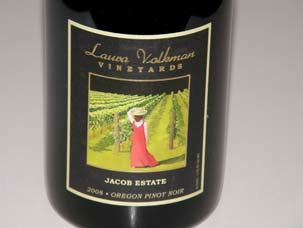 2008 Laura Volkman Jacob Estate Willamette Valley Pinot Noir 13.5% alc., $50. From estate grown fruit in the East Block of the vineyard containing Dijon clones 777, 115 and 114. Barrel aged on the lees in 50% new French oak. · An alluring nose of exotic scents including dark red raspberries, rose petals, Asian spices and seasoned oak. A challenge to describe adequately. Very tasty essence of fresh fruits including plums, berries and pomegranates veering more to the purple spectrum. Ridiculously silky and almost ephemeral, like swallowing flavored air. A wonderful wine with mature dry tannins perfectly balanced by the ripe fruit and lively acidity. Will provide several years of drinking enjoyment.
2007 Laura Volkman Vineyards Rachel Estate Oregon Pinot Noir 13.2% alc., 95 cases, $38. · The nose will bring you to your knees. Merci! Lovely perfume of dark red berry melange, rose petals, cola and oak bark. Delicious well-spiced black cherry and deep red berry flavors with a hint of cherry cola and baking spices. Beautifully composed with soft ripe tannins and a caressing silkiness you can cozy up to. I loved this wine last year when I reviewed it and I am sticking to my guns.
2007 Laura Volkman Vineyards Jacob Estate Oregon Pinot Noir 13.5% alc., 120 cases, $45. · The aromas elevate with time in the glass revealing scents of blackberries, loganberries, bay leaf and oak. Layered flavors of spiced plum, dark berries, dried cranberries, pine sap, savory herbs and loamy earth. As the name implies, a little more masculine wine than the Rachel with firmer tannins. Very good.
The Laura Volkman Vineyards labels display artwork from noted watercolor artist, Terry Peasley, depicting Laura in her vineyard. A Chardonnay from Celilo Vineyard (Wente Clone) in the Columbia Gorge region of Washington, named after the family dog, Bella, is also available ($25). Total production is less than 500 cases. The wines are sold through a mailing list and through the online store at www.volkmanvineyards.com. Tasting is available by appointment at the Volkman’s quaint tasting room in a former garage adjacent the vineyard Monday-Saturday (503-806-4047).
Antica TerraAntica Terra (la antica terra is Latin for “old earth”) has quickly become one of Oregon’s most applauded Pinot Noir producers. A pair of New Yorkers originally planted a 6-acre estate vineyard on 40 acres in the Eola-Amity Hills appellation of the Willamette Valley in 1989 and named it Antica Terra. The vineyard and label were acquired in 2005 by three friends (Scott Adelson, John Mavredakis, Michael Kramer) in partnership with winemaker Maggie Harrison. Harrison was an assistant winemaker for Manfred Krankl at Sine Qua Non in Ventura, California for eight years (1998-2006). She was so fond of working with Krankl that he had to practically lock the doors to his winery to force her out on her own. It took a unique opportunity afforded by Antica Terra that led to her to take the leap. Listen to Harrison’s full story on Grape Radio Show #232 at www.graperadio.com/archives/2009/02/02/life-with-maggie/. See Harrison on You Tube at www.youtube.com/watch?v=4ghYp6zV8TA The Antica Terra Vineyard is situated on a south-facing sloping hillside with shallow and well drained soil underlain with marine sedimentary rocks and alluvial deposits and offers expansive views of the Williamette Valley. The stratification of the earth in the Antica Terra Vineyard is depicted on the winery’s label. 20 additional acres of Pinot Noir were added to the vineyard in 2007 adding to the clonal and rootstock mix. The inaugural release under Harrison’s direction was the 2006 vintage and the wines have been highly praised by the wine press ever since. The 2006 vintage consisted of 1,100 cases of the Antica Terra Willamette Valley Pinot Noir and less than 100 cases of Antica Terra Botanica. In 2007, production was 1,280 cases and 20 cases respectively. The Willamette Valley bottling is a blend of estate Antica Terra Vineyard fruit and purchased fruit from the Cherry Grove Vineyard and Shea Vineyard, both located in the Yamhill-Carlton District appellation. The percentage of each varies with every vintage, but the estate vineyard usually makes up about 50% of the blend. A second reserve bottling, Botanica, is a small production Pinot Noir made only in vintages when exceptional fruit warrants. It has a similar composition to the Willamette Valley bottling in 2008.
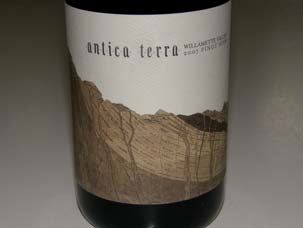 2008 Antica Terra Willamette Valley Pinot Noir 13.5% alc., 1,111 cases, $46. Released April 1, 2010. 52% Antica Terra, 27% Shea and 21% Cherry Grove vineyards. 90% de-stemmed without crushing (10% whole cluster). Aged in 31% new and 69% 1 to 3-year-old French oak barrels. Never racked until sent into tank for bottling. Unfined and unfiltered. · Moderate reddish-purple color in the glass. Well-perfumed with aromas of spiced berries, savory herbs, lavender and cut flowers. Classy juice that is both bright and lithe with flavors of dark berries, cherries, mocha and savory herbs. Drinkable now, but will be much better in another 6 to 12 months. Very good.
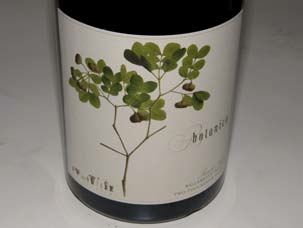 2008 Antica Terra Botanica Willamette Valley Pinot Noir 13.7% alc., 185 cases, 120 magnums, $75. Released April 1, 2010. 50% Antica Terra, 38% Shea and 12% Cherry Grove vineyards. De-stemmed 89% without crushing. 11% whole cluster. Aged in 63% new and 37% seasoned French oak barrels. · The nose is reticent initially, becoming more charming with time in the glass showing a melange of berry fruits, Herbs de Provence and a hint of oak. Lovely depth and richness of flavor featuring the entire array of berries including boysenberry, blackberry and strawberry with an underpinning of savory herbs. A charming wine with supple tannins, bright acidity and fruit in perfect harmony. Needs plenty of foreplay (translate: decanting) to drink now. A magnificent effort that will reward long term cellaring.
Antica Terra wines are available through a mailing list at www.anticaterra.com with some retail distribution (check www.avalonwine.com). An outstanding Rosé was also released in 2008 and previously reviewed in the PinotFile. Tasting by appointment (503-244-1748).
More Sips of Noiregon Pinot
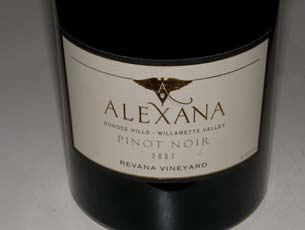 2007 Alexana Revana Vineyard Dundee Hills Willamette Valley Pinot Noir 13.5% alc., $38. The inaugural estate Pinot Noir. Six clones including 113, 115, 667, 777, Pommard and Wädenswil. The winemaker is Lynn Penner-Ash. The proprietor is Dr. Madaiah Revana who named this wine as a tribute to his daughter Alexandra. · Moderate garnet color in the glass. Lovely and seductive nose which hints at gardenias upon opening, evolving to reveal aromas of strawberry tart, baking spices and red cherries. Soft and elegant on the palate with gossamer tannins, offering the delicious essence of fresh red berry fruits with herbs, toasty oak, and spices under tow. A feminine expression of Pinot Noir that holds considerable charm.
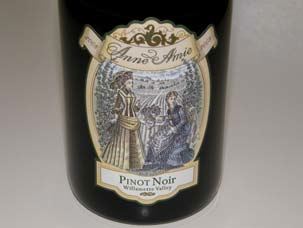 2008 Anne Amie Willamette Valley Pinot Noir 13.5% alc., $35, screw cap. Release date is Novermber 2010. Sourced from 10 vineyards including 22% estate fruit. Willakenzie, Laurelwood and Jory soils. Clones Pommard 4, Dijon 114, 115, 667, 777 and 828. Aged 10 months in 26% new, 20% 1 year and 54% neutral French oak barrels. · Moderate reddish-purple hue in the glass. Fresh aromas of dark red berries and a hint of clove. Tasty potpourri of cherries, strawberries and raspberries with a tangy citrus note adding a spring to the pleasing finish. Relatively straightforward but drinks really well. An outstanding Willamette Valley blend. Very good.
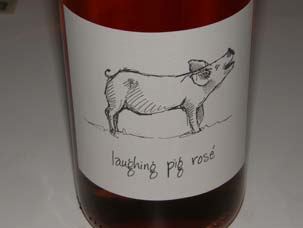 2009 Big Table Farm Laughing Pig Willamette Valley Pinot Noir Rosé 14.1% alc., 100 cases, $22. Sourced from Cattrall Vineyard which is the oldest certified organic vineyard in Oregon. Barrel fermented to dryness, complete MLF and aged sur lies until the day before bottling. Attractive tall Alsatian bottle. · Light rose color. Pleasing aromas of cherries, strawberries, prickly pear and rose garden. Moderately rich flavors of red cherries and strawberries with an underpinning of minerality and a tangerine peel note on the bright finish. This is a friendly wine that will please any rosé fan. Very good.
The following five wines represent my first experience with Coeur de Terre Vineyard wines. Established in 1998 by Scott and Lisa Neal, the vineyard is located in the Coast Range foothills of the McMinnville appellation west of the town of McMinnville, Oregon. Coeur de Terre, which is French for “Heart of the Earth,” was inspired by a large heart-shaped rock found during the establishment of the estate vineyard. The 50 acre property includes a winery and 17 acres planted primarily to Pinot Noir in soils of both sedimentary and volcanic origins. The owners planted the vineyard themselves and it has been farmed using organic and sustainable methods since its inception. Over 80,000 vines were hand grafted at the estate’s nursery and been the parent material for nearly all the vineyard. Planting of the vineyard was conducted from 1999 to 2007 with multiple Pinot Noir clones including Dijon 115, 667 and 777, Pommard, Wädenswil, and field blend selections. Coeur de Terre produces Pinot Noir (an Oregon Pinot Noir, Estate Pinot Noir and four block designated Pinot Noirs), Pinot Gris, Riesling and Rosé. Pinot Noir winemaking is traditional using small open top fermentors, employing a cold soak when appropriate, using manual punch downs, and using both indigenous and cultured yeast strains. The wines are racked directly to barrel with free run kept separate from press fractions. Aging is carried out for 10 to 18 months in French oak barrels. A gravity flow system is employed in the winery. The Coeur de Terre Pinot Noirs are impressive in that one can taste McMinnville terroir in these wines. I did not taste the 2008 block designated Pinot Noirs as they have not been included with the other 2010 spring releases. For more information, visit www.cdtvineyard.com. The winery is open by appointment (503-472-3976, extension 2).
2009 Coeur de Terre McMinnville Willamette Valley Rosé Rustique 13.3% alc., pH 3.45, $17. Released May 1, 2010. A blend of Pinot Noir from Hyland Vineyard (Coury clone), Syrah from Coeur de Terre Estate Vineyard, and Riesling from Hyland Vineyard. Pinot Noir grapes were de-stemmed and pressed off the skins after 3 days, Syrah grapes were de-stemmed and sat on the skins for 1 day. A small amount of juice was saigneed from the Syrah and added to the pressed off Pinot Noir. Fermented in stainless fermentors using 3 yeast strains. Cold stabilized and sterile filtered before bottling. · Demure aromas of strawberries, taffy, melon and a touch of lavender. Slightly confected red strawberry core with hints of orange peel, cranberry and honeydew melon. Light and refreshing. Decent.
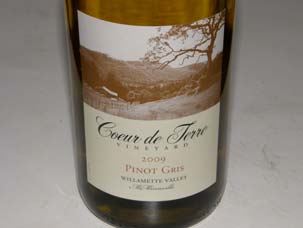 2009 Coeur de Terre Vineyard McMinnville Willamette Valley Pinot Gris 12.7% alc., pH 3.15, 248 cases, $17. Released May 1, 2009. Sourced from the Coleman Vineyard in the McMinnville AVA. De-stemmed and pressed off immediately. 20% was racked to neutral oak puncheon and 80% to stainless tank. Residual sugar 10g/L. Cold stabilized and sterile filtered before bottling. · Very pale yellow color in the glass. A pleasing potpourri of tropical fruits and white peaches with notes of cut grass and lemon curd. Easygoing with a crisp finish. A fine example of this style. Good.
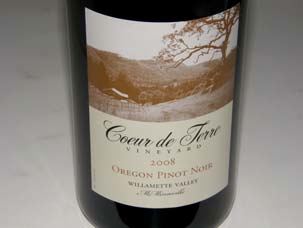 2008 Coeur de Terre Vineyard McMinnville Willamette Valley Pinot Noir 13.8% alc., pH 3.72, 473 cases, $20. Released May 1, 2010. Estate grown and bottled. The wine is crafted from fruit from younger vines combined with more mature fruit from Renelle’s Block for structure and balance. Cold soak for 3 days, free run and press sent to barrel, indigenous and commercial yeast fermentation, aged 11 months in 30% new, 60% seasoned and 10% neutral French oak barrels. Bottled unfined and unfiltered. · Enticing aromas of earth-kissed dark stone fruits with notes of oak toast, anise and mint in the background. Plum and cherry cola are the flavor theme but it is the earthiness that is most striking. One can taste the soil in this wine. Easy drinking with reigned in dry tannins and a refreshing finish. Good.
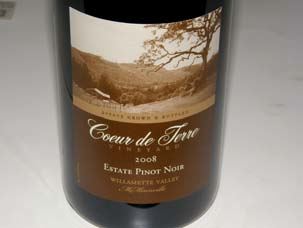 2008 Coeur de Terre Vineyard Estate McMinnville Willamette Valley Pinot Noir 13.8% alc., pH 3.74, $34. Released May 1, 2010. Estate grown fruit only including a combination of younger vines and more mature fruit. Cold soak for 3 days, free run and press sent directly to barrel, fermentation with indigenous and commercial yeasts, racking if necessary, aged 14 months in 30% new, 60% seasoned and 10% neutral French oak barrels. Unfined and unfiltered. · Shy but charming perfume of darker fruits with toasty oak to the front. Similar to the Oregon bottling but more refined with softer tannins. Black cherry and blackberry flavors with underpinnings of earthy loam, minerals, tobacco and toasty oak. Nicely crafted and very promising, but needs time like so many 2008 Oregon Pinot Noirs. Good (+).
2007 Domaine Drouhin Oregon Willamette Valley Pinot Noir 13.9% alc., $40. 100% de-stemmed, vinified at the four-level gravity flow winery. Aged in approximately 20% new French oak barrels which are custom made in Burgundy. 95% estate fruit. · Moderate reddish-purple color in the glass. Shy dark red cherry and berry aromas with hints of spice and oak. Crisp and juicy dark red cherry and raspberry melange with an underpinning of savory herbs and spices. Lacking in nuances but drinking nicely. An impressive effort from a challenging Oregon vintage. This is a winery you can rely on for consistency. Very good
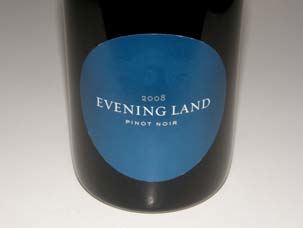 2008 Evening Land Vineyards Oregon Pinot Noir 13.4% alc., $25. Mostly Seven Springs Vineyard fruit. Consulting winemaker if Frenchman Dominque Lafon. · Moderately intense reddish-purple color in the glass. Dark fruits including plums and ollaliberries are featured on the nose with aromatic hints of spice, balsam and sawdust. Well-endowed with caressing fruit which persists on the finish. A California styled wine without all the alcohol. Good.
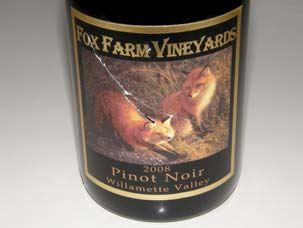 2008 Fox Farm Vineyards Willamette Valley Pinot Noir 13.3% alc., 292 cases, $28, screw cap. · Attractive perfume of red fruits, spice, and underbrush with a hint of alcohol. Medium-weighted dried cherry and cranberry flavored core with a rush of tart cherries at the finish. Hi-strung style with bright acidity, minimal tannins and a pleasingly smooth mouth feel. Good.
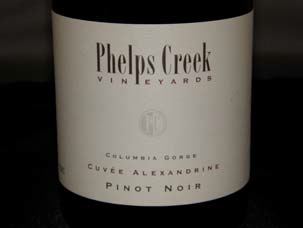 2007 Phelps Creek Vineyards Cuvée Alexandrine Columbia Gorge Pinot Noir 13.5% alc., $40. French vigneron Alexandrine Roy comes from Gevrey- Chambertain to craft this wine at Phelps Creek Vineyards in Hood River, Oregon. · Initially the nose and flavors are dominated by oak-derived notes of toast, dark caramel, toasted marshmallow, dark chocolate and toast. There is a beautiful and ripe deep red fruit core underlying the oak blanket. Tasted later in the day from a bottle opened in the morning, the wine had changed dramatically with the oak influence receding and charming fruit aromas and flavors rising to the forefront. This wine will definitely benefit from cellaring to allow further integration of the oak. If you open a bottle now, decant it for several hours before drinking. Very good.
 2008 Plowbuster Willamette Valley Pinot Noir 14.5% alc., $21. Second label from Carabella Vineyard, a 49-acre site on the southeastern side of Parrett Mountain in the Chehalem Mountains AVA. Winemaker Mike Hallock makes wines exclusively from Carabella Vineyard fruit. 27 acres are planted to five Pinot Noir clones in Nekia and Jory soils. The name, Plowbuster, gets its name from the dry farming method Hallock and his team use. · Moderately light reddish-purple color in the glass. Nicely composed aromatic profile of slightly confected cherries and strawberries with notes of spice and savory oak. Tasty cherry core with a comforting soft texture and gossamer tannins. This wine exudes finesse and charm. High quaff-ability quotient. Still drinking fine the next day from a previous opened and re-corked bottle. Good (+).
2008 Scott Paul D122 Ribbon Ridge Vineyard Oregon Pinot Noir 13.1% alc., $30, screw cap. D122 is the narrow road that winds through grand cru vineyards of Burgundy’s Cote de Nuits. Sourced from Pommard and Dijon clones planted in 2001. · Highly perfumed with scents of strawberries, rose hip, spice, spring bouquet and underbrush. Light and demure featuring flavors of red cherries and raspberries, cherry soda and edible flowers. A highly floral and intensely perfumed wine that is simply composed. Decent.
 2008 Scott Paul Audrey Dundee Hills Pinot Noir 13.1% alc., $65, screw cap. A barrel selection of the finest of the vintage sourced from Maresh Vineyard which was originally planted in 1970. · This wine is currently holding back and needs a year or two of cellaring. Enticing aromas of wild berries, cherry tart and baking spices. Tasty core of cherry and berry fruit, discreetly rich, with a loamy underpinning. The mouth feel is satiny and the generous finish is lengthy and satisfying. The pedigree of the fruit is evident even at this reluctant stage. Very good.
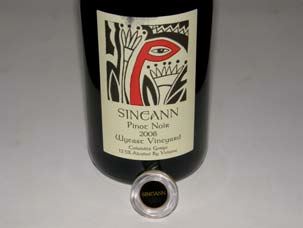 2007 Sineann Wyeast Vineyard Columbia Gorge Pinot Noir 13.5% alc., $35, Vino-Seal glass closure. From a vineyard in the Hood River Valley farmed by Dick and Christie Reed. · Moderately deep reddish-purple color in the glass. Patience is required to fully enjoy this wine. I found it grows on you as it gets significantly better over time in the glass. Appealing aromas of dark red cherries and berries with a hint of toasty oak. Delicious essence of fresh cherries and berries with a hint of soy and cherry skins. Beautifully balanced with bright acidity on the showy finish which sails along. This wine clearly shows the promising potential for Pinot Noir in the Hood River region of Oregon.
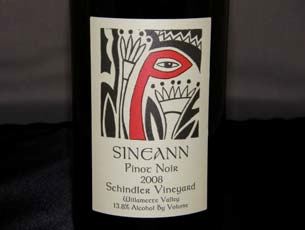 2008 Sineann Schindler Vineyard Willamette Valley Pinot Noir 13.8% alc., $35. Vino-Seal glass closure. This vineyard is farmed by Robert and Janet Schindler and is located northwest of Salem. · Moderately dark reddish-purple hue in the glass. Reserved aromas of dark stone fruits with a sidecar of smoky oak. Soft in the mouth with caressing tannins, and a black cherry fruit core that is moderately rich and perfectly ripe. Still somewhat brooding and linear at this stage. This wine underwent an amazing transformation with much more fruit expression and charm when tasted the following day from a previous opened and re-corked bottle. Cellar or decant if you drink now. Very good.
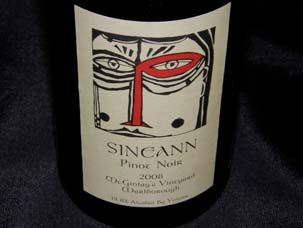 2008 Sineann McGinlay’s Vineyard Marlborough New Zealand Pinot Noir 14.8% alc., $30. Sourced from one of the few hillside sites in Marlborough. Produced and bottled in New Zealand. · Sexy perfume of red fruits and baking spices. Tasty red berry core with impressive mid palate intensity and mouth coating persistence. Notes of herbs and seasoned oak in the background add interest. Well-structured for the long haul. Better the next day from a previously opened and re-corked bottle. Very good (+).
This glass and polymer wine bottle closure is made by Alcoa and known in Europe as Vino- Lok. It consists of an attractive looking decanter glass stopper with a flexible and inert o-ring around its base to provide a sterile seal. The glass stopper is held in place by a tin capsule and neck sleeve (the Vino-Lok uses an aluminum cover cap). Oxygen transmission is said to be similar to a tin-lined screw cap. A big advantage of this type of closure is that the risk of cork taint is zero. The closure is also recyclable. The main disadvantage is the added cost over cork and the necessity for special bottling equipment to insert it. The glass closure has become popular in Germany, Austria and Italy, and in Europe over 350 wineries currently use it. In 2006, Napa Valley's Whitehall Lane was the first winery to seal its bottles of select premium wines with the Vino-Seal closure. Calera is currently the biggest United States customer of Vino-Seal glass closures which are used on the Calera Central Coast Pinot Noir and Mt. Harlan Cuvée Pinot Noir. I love the aesthetic of this closure. Vino-Seal is safe to use, easy to open with a twist, and can be used to quickly reseal a bottle over and over. Wine can be aged standing up as well.
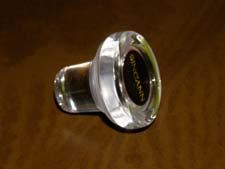
2007 Tyee Wine Cellars Estate Willamette Valley Pinot Noir 13.5% alc., $19.99. · Moderate reddish-purple hue in the glass. Initial bright aromas of cherries, red berries and soy sauce fading some in the glass with a minty, green note emerging. Lighter-weighted red and black fruits with a hint of oak and a subtle lift of citrus peel on the finish. Soft in the mouth with reigned-in tannins. Decent.
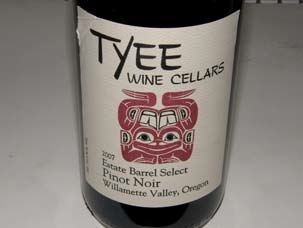 2006 Tyee Wine Cellars Estate Barrel Select Willamette Valley Pinot Noir 14.1% alc., $29.99. · Moderately light in color in the glass. Aromas of ripe dark fruits, oak toast and leather. Juicy red cherry and berry fruits which are vivid and focused wrapped in moderately firm tannins. Nicely crafted with a silky mouth feel and admirable persistence on the back end. Very good.
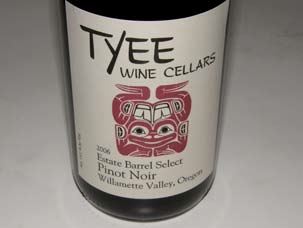 2007 Tyee Wine Cellars Estate Barrel Select Willamette Valley Pinot Noir 13.5% alc., $29.99. · Moderate reddish-purple color in the glass. Shy, but appealing scents of cherry and berry jam with hints of oak and spice. Decent red berry core with moderate ripe tannins and some persistence on the elegant finish. A solid wine. Good.
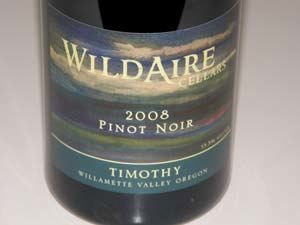 2008 WildAire Cellars Timothy Willamette Valley Pinot Noir 13.3% alc., $20. Proprietor and winemaker Matt Driscoll crafts his wines at Illahe Vineyards in the Polk County Hills between Dallas and Monmouth. He sources grapes from several AVAs including Chehalem Mountains, McMinnville and the Rogue Valley. Matt and his wife Jean have a tasting room in Carlton. The name, WildAire, is from a family estate in Roanoke, Virginia. The name was found while hiking the Appalachian Trail carved into a granite fireplace mantle in a Ranger Station. The wine is dedicated to Matt’s father who loved to hike. · Vivid and nuanced nose sporting aromas of spiced dark stone fruits, pine pitch, exotic woods and menthol. Generous core of plum, dried cherry and cranberry fruit with notes of pine sap and grass. Grainy dry tannins lend a velvety texture to the wine. Picks up aromatic and flavor intensity and interest in the glass over time. Good (+).
Looking Under 14.0%Some of my readers have inquired about the availability of Pinot Noirs with under 14.0% alcohol from North America. This led me to survey alcohol levels of the 2007 vintage from each of the major Pinot Noir producing appellations in California and the Willamette Valley of Oregon. My goal was to discover which regions had the most Pinot Noirs under 14.0% or averaged under 14.0%. I surveyed between 8 and 25 well-known wineries in each appellation. I took the readings from tech sheets on the winery’s websites which tend to be more accurate than label figures because the tech sheets are created at or shortly after the time of a wine’s release. Labels are often printed months in advance and as the wine ages in barrel before release, the alcohol level frequently changes a small amount. What is so magical about 14.0% alcohol? Government regulations in the United States (TTB) require that the alcohol percentage appear on the front or back label unless it is 14.0% or less in which case the label may simply state “table wine” or “light wine.” Regulations do not require that the alcohol level on the label be precise. The allowed margin of error for wines 14.0% or under is 1.5% and for wines over 14.0% alcohol is 1.0%. Therefore, a label that reads 12.5% alcohol, may have anywhere between 11.0% and 14.0% alcohol. Any wine with 14.0% and above alcohol level cannot be labeled with less than 14.0% alcohol and vice versa, a wine under 14.0% alcohol level cannot be labeled as above 14.0%. A wine with 13.5% alcohol cannot be labeled 15.0% and likewise, a wine with 14.5% alcohol cannot be labeled 13.5%. Got it? Wines with alcohol at or below 14.0% have less of a tax burden. Sta.Rita Hills With the long growing season in this appellation, it is hard to craft Pinot Noirs with less than 14.0% alcohol unless some alcohol reduction technique is employed. I found nine wines with less than 14.0% alcohol: 2007 Babcock Grand Cuvée (13.7%), 2007 Babcock Rita’s Earth (13.5%), 2007 Clos Pepe Estate Clos Pepe Vineyard (13.9%), 2007 Clos Pepe Estate Clos Pepe Vineyard Vigneron Select (13.9%), 2007 Drew Gatekeeper (13.8%), 2007 Lafond Arita Hills (13.8%), 2007 Longoria Rancho Santa Rosa (13.9%), 2007 Longoria Lovely Rita (13.9%), and 2007 Fe Ciega (13.9%).
Range of alcohol percentage (2007): 13.5% - 15.8%
Santa Maria Valley I found seven wines from 2007 that had less than 14.0% alcohol: 2007 Au Bon Climat Bien Nacido (13.5%), 2007 Fess Parker Bien Nacido, 2007 Kynsi Bien Nacido (13.9%), 2007 La Fenetre Le Bon Climat (13.5%), 2007 Lane Tanner Bien Nacido (13.9%) and Julia’s (13.8%), and 2007 Landmark Solomon Hills (13.8%).
Range of alcohol percentage (2007): 13.5% - 15.8%
Santa Cruz Mountains I found six 2007 Pinot Noirs from Rhys Vineyards under 14.0% alcohol: Alpine Road (13.0%), Horseshoe Ranch (12.3%), Family Farm (13.3%), Skyline (13.0%), Home (13.3%), and Alpine Swan Terrace (13.3%). Also, 2007 Muns Vineyard (13.9%), 2007 Mount Eden (13.8%), 2007 Thomas Fogerty Rapley Trail B Block (13.8%) and M Block (13.7%), 2007 Windy Oaks Estate Cuvée (13.9%).
Range of alcohol percentage (2007): 13.3% - 15.0%
Santa Lucia Highlands I found two 2007 wines with alcohol level below 14.0%: 2007 Cima Collina Tondre Grapefield (13.1%) and 2007 Roar Garys’ (13.8%).
Range of alcohol percentage (2007): 13.1% - 15.1%
Russian River Valley I found twenty-two 2007 Pinot Noirs under 14.0% alcohol: 2007 BPinot (13.9%), 2007 Balletto Burnside (13.9%) and Winery Block (13.9%), 2007 D&L Carinalli (13.6%), 2007 De La Montanya Felta Creek Pinot Squared (13.6%), 2007 DXG RRV (13.85%), 2007 george Ceremonial (13.5%), Hansen (13.6%), and Martaella (13.9%), 2007 Dutton-Goldfield Sanchietti (13.5%) and Freestone Hill (13.5%), 2007 Joseph Jewell Appian Way (13.5%), 2007 Joseph Swan Vineyards Cuvee de Trois (13.8%), 2007 Longboard (13.7%), 2007 Pali Wine Co Inman Olivet (13.6%), 2007 Paradise Ridge (13.7%), 2007 Pillow Rd. Vineyard (13.6%), 2007 Roessler Dutton Ranch (13.8%), 2007 Williams Selyem Riverblock (13.9%), Allen (13.8%), Westside Road Neighbors (13.8%), and Bucher (13.9%).
Range of alcohol percentage (2007): 13.5%-15.1%
Sonoma Coast I found twenty-two 2007 Pinot Noirs under 14.0% alcohol: 2007 Anthill Farms Peters (13.6%), 2007 C. Donatiello Hervey (13.6%), 2007 Ceritas Escarpa (13.7%), 2007 Chronicle Sonoma Coast (13.8%), 2007 Cobb Coastlands (13.9%), Joy Road (13.8%), and Rice-Spivak (13.3%), 2007 Drew McDougall (13.5%), 2007 Dutton-Goldfield McDougall (13.5%), 2007 Flowers Sonoma Coast (13.4%), 2007 Fogdog (13.5%), 2007 Freestone Pastorale (13.5%) and Quarter Moon (13.5%), 2007 Freestone Vineyards (13.5%), 2007 Littorai Hirsch (13.8%) and B.A. Thieriot (13.6%), 2007 Pali Wine Co Durrell (13.6%) and Thorn Ridge (13.9%), 2007 Rivers-Marie Willow Creek (13.8%), Summa (13.2%) and Summa Old Vines (13.4%), and Woodenhead Buena Tierra (13.9%).
Range of alcohol percentage (2007): 13.2% - 15.8%
Carneros I found nine 2007 Pinot Noirs with less than 14.0% alcohol: 2007 Artesa Carneros (13.9%), 2007 Buena Vista EVS Swan Selection (13.9%), 2007 Ceja Carneros (13.8%), 2007 Domaine Carneros Avant-Garde (13.8%) and Estate (13.8%), 2007 Mi Sueno (13.7%), 2007 Schug Carneros Estate (13.5%), Iund (13.5%), and Estate Block 10 (13.5%), Robert Sinskey Vineyards Carneros (13.6%), Three Amigos (13.6%), Vandal (13.7%) and Four Vineyards (13.6%), ZD Carneros (13.9%) and Norman de Leuze Founder’s Reserve (13.9%).
Range of alcohol percentage (2007): 13.5% - 15.6%
Anderson Valley I found seventeen 2007 Pinot Noirs with less than 14.0% alcohol: 2007 Anthill Farms Demuth (13.8%), 2007 Brogan Cellars Morning Dew Ranch (13.6%), 2007 Copain Baker Ranch (13.5%) and Hacienda Sekoya (13.5%), 2007 Coulour Roma’s (13.85%) and Monument Tree (13.52%), 2007 Drew Fog-Eater (13.7%), Savoy (13.9%) and Monument Tree (13.8%), 2007 Greenwood Ridge Mendo Ridge (13.8%), 2007 Husch Vineyards (13.9%) and Husch Nash Mill (13.9%), 2007 LIOCO Demuth (13.8%), 2007 Littorai Savoy (13.5%), 2007 Navarro Vineyards Deep End Blend (13.9%), 2007 Phillips Hill Marguerite (13.9%), and Williams Selyem Ferrington (13.9%).
Range of alcohol percentage (2007): 13.5% - 14.95%
Other California regions: 2007 Au Bon Climat Isabelle (13.5%), 2007 Kendric Vineyards Marin County (13.9%), 2007 Dutton-Goldfield Devil’s Gulch Ranch (13.9%), 2007 Williams Selyem Vista Verde Vineyard San Benito County (13.9%), 2007 Castle Rock Monterey County (13.5%), 2007 Praxis Monterey County (13.5%), 2007 La Crema Monterey County (13.8%), 2007 Lucas & Lewellen Santa Barbara County (13.0%), 2007 McMurray Ranch Central Coast (13.0%), 2007 Olivia Brion Wild Horse Valley (13.9%), 2007 Lucky Star California (13.5%), and 2007 Mark West California (13.8%). Willamette Valley, Oregon Wines with more than 14.0% alcohol were the exception in the Willamette Valley in the 2007 vintage. Oregon Pinot Noirs show more variability in alcohol levels from vintage to vintage. In 2003 and 2006, for example, the alcohol levels were similar to California and many wineries bottled Pinot Noirs with alcohol levels significantly above 14.0%. I found 53 wines from the 2007 vintage that I had reviewed that were less than 14.0% alcohol. Producers to look for include Anam Cara Cellars, Anne Amie Vineyards, Antica Terra, Arterberry Maresh, Bethel Heights, Cardwell Hill Cellars, Domaine Drouhin Oregon, Evesham Wood, Kelley Fox, Ken Wright, Laura Volkman, Pali Wine Co, Patricia Green Cellars, Rocco, Roots, Scott Paul, Shea Wine Cellars, Solena, Soter Vineyards, St. Innocent, The Eyrie Vineyards, The Four Graces, Van Duzer, Verve, and Willakenzie,
Range of alcohol percentage (2007): 12.7% -14.5%
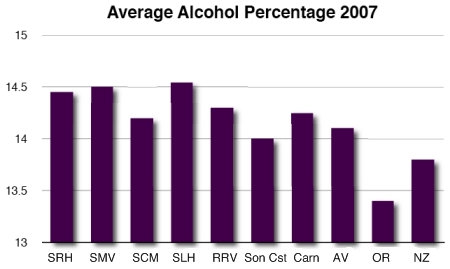 At Pinot Noir 2010 held in Wellington earlier this year, Steve Smith MW stated that the United States version of Pinot Noir “are too high in alcohol.” I looked at 43 2007 and 2008 New Zealand Pinot Noirs from the country’s three major Pinot Noir growing regions (Martinborough, Marlborough and Central Otago).
Range of alcohol percentage: 13.0% - 14.6%
In summary, look to these California producers for producing Pinot Noirs under 14.0%: Au Bon Climat, Lane Tanner, Dutton-Goldfield, george, Cobb, Freestone, Rivers-Marie, Littorai, Williams Selyem, Schug Carneros Estate, Robert Sinskey Vineyards and Drew Wines. Oregon clearly has the most number of wines under 14.0% alcohol in certain vintages such as 2007.
Rivers-Marie: Still the OneAs I compose this issue of the PinotFile the day before Father’s Day, I am dreaming of my planned lunch with my wife Patti and son Garrick (my younger son who does all the PinotFile website management lives in Austin, Texas) at my favorite restaurant, Marché Moderne. The wine I have chosen to bring from my cellar for the occasion is the 2007 Rivers-Maria Summa Old Vines Sonoma Coast Pinot Noir. If someone were to say, “I will grant you eternal life or a couple bottles of Rivers-Marie Summa Old Vines Pinot Noir, I’d take the Rivers-Marie every time. Winemaker Thomas Rivers Brown and his wife Genevieve Marie Walsh have quietly developed one of California’s most revered cult Pinot Noir labels. Brown’s background doesn’t hint of his eventual success in the wine business. Hailing from South Carolina, Brown majored in English literature and game theory at University of Virginia, two subjects that are about as disconnected from enology as one can imagine. He arrived in California in 1996 after his schooling with a newly hatched love of wine, attempting to break into the wine business. He had no leads or connections whatsoever and simply began knocking on doors. Aaron Jordan, the winemaker at Turley Wine Cellars, finally hired him. This was to become a very fortuitous hire as Aaron subsequently introduced Brown to Scott and Joan Zeller, the owners of the 60-acre Summa Vineyard, located in the Occidental region of the true Sonoma Coast. As Brown launched his own Rivers-Marie label in 2002, Summa Vineyard was his only source for Pinot Noir, but it was eventually to lead to several other important sources of grapes nearby. Today, Rivers-Marie produces tiny amounts of Pinot Noir from three vineyard sources in the true Sonoma Coast, more specifically the Occidental-Freestone area. Besides Summa Vineyard, Pinot Noir is harvested from Occidental Ridge Vineyard, owned by Richard and Darla Radcliffe, which debuted in 2005, and the Willow Creek Vineyard, two acres owned by Raleigh and Patricia Wilson-Juckett, which debuted in 2006. Total production for Rivers Marie in 2007 was 650 cases. It is no wonder there are over 4,000 people on the waiting list hopelessly biding their time to obtain a spot on the mailing list. Managing allocations is more challenging for Brown than crafting the wines! Brown is better known in Napa Valley than in Sonoma where he has a hand in crafting wine for fifteen different wineries, processing 300 tons of grapes annually, primarily Cabernet Sauvignon. He works out of the Black- Sears Winery on Howell Mountain that Ted Lemon of Littorai left behind after moving to Sebastopol. He also has a second Pinot Noir project with Schrader Winery partners, Aston Estate, producing clonal specific Pinot Noirs from the Annapolis region in the true Sonoma Coast (www.astonestate.com). The 2007 Rivers-Marie Pinot Noirs were show stoppers (www.princeofpinot.com/article/719/) needing a rating category above the Pinot Geek, and the 2008 vintage wines are a spectacular group of wines as well. The grapes are 100% de-stemmed of each wine. The oak regimen in 2008 varies from 25% new for the Sonoma Coast, 40% new for the Occidental Ridge, 60% new for the Summa, to 100% new for the Summa Old Vines Pinot Noir. Coopers are a mix of Remond, Taransaud and Francois Freres. All the wines have an appealing deep, dark reddish-purple robe. Brown’s comments about the 2008 vintage: “The 2008s begin with their backbone and will take some time to round out. It is definitely a red/orange fruit focused year and acidities are a bit higher than in 2006 and 2007.” A new vineyard, Silver Eagle, which is farmed by Ulises Valdez, was sourced in 2009 which looks like a generous production year. Although you can add your name to the Rivers-Marie waiting list at www.riversmarie.com, you might be better served to seek out bottles on the secondary market. A Chardonnay from the famed Thieriot Vineyard located in the Sonoma Coast also become part of the lineup with the 2007 vintage. A Rivers-Marie Cabernet Sauvignon from Howell Mountain is available as well. Prices are very sensible considering the quality.
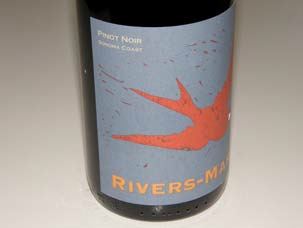 2008 Rivers-Marie Sonoma Coast Pinot Noir 14.1% alc., 225 cases, $25. An earlier drinking wine composed of younger blocks of Summa Vineyard and other barrels from Occidental Ridge and Willow Creek (production was tiny and all of it went into this bottling). · Exciting scents of boysenberries, brioche, seasoned oak and a swirl of spices. The most showy nose in the lineup. Discreetly rich in the mouth, with a wave of black cherries, dark berries, cola, smoke and savory herbs wrapped in peach-skin tannins that combine in a very pleasurable drinking experience. Very good.
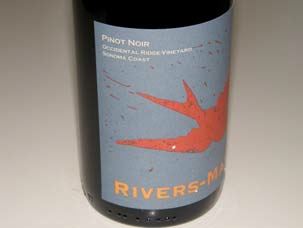 2008 Rivers-Marie Occidental Ridge Vineyard Sonoma Coast Pinot Noir 14.1% alc., pH 3.50, 225 cases, $45. · This one will make the hair on your neck stand erect. Lovely aromas of freshly picked red and black berries and cherries nicely spiced with hints of soak and sage. In the mouth I was at a loss for descriptors. My notes say, “Amazing fruit, want more, really attacks, great juice, class in the glass.” This wine has that California fruit viscosity that makes you proud to be an American, and an addictive and refreshing ending in which the fragrance returns to haunt the finish. It was scary that this wine was better later in the day from a bottle opened earlier in the morning. Imagine what this wine will be like in a couple of years!
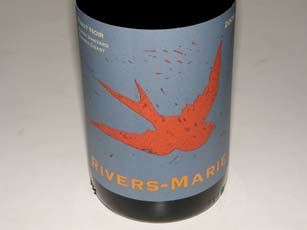 2008 Rivers-Marie Summa Vineyard Sonoma Coast Pinot Noir 14.1% alc., 200 cases, $45. · Enticing perfume of fresh red stone fruits and berries with exotic spices and baked apple. Delicious melange of dark red cherries and berries with nuances of dark chocolate, Moroccan spices, anise, smoke, and savory herbs. The fruit is robust, virile and mouth coating and persists through a generous finish. A whisper of tannin makes for approachability now. A top-shelf Pinot Noir that has the goods and balance to improve in the cellar over the next several years.
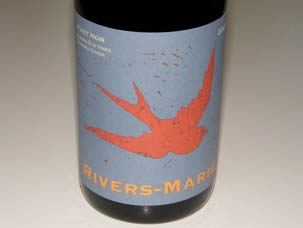 2008 Rivers-Marie Summa Old Vines Sonoma Coast Pinot Noir 14.1% alc., 175 cases, $60. · Intoxicating aromas of wild berries and black cherries and other pheromone scents that make you giddy. Structured and stuffed with an entirely seductive and ever-expanding arsenal of dark red cherries, berries and currants underlain with a subtle smokiness, haunting earthiness and a hint of mushrooms on the grill. Enough tannins for the long haul and balancing acidity to hold the fruit in check. The finish goes on and on, leading to a veritable winegasm. Still tightly wound but considerable upside potential long term.
Rippon Pinot Noir is Stunning in 2008Sir Percy Sargood (Emma Rippon’s grandson) bought Wanaka Station in 1912. Rolfe Mills (Percy Sargood’s grandson) and his wife Lois took a section of this land, one of the last vestiges of the original Wanaka Station, and created Rippon. Rolfe Mills’ early trials with Vitis vinifera plantings acknowledged him as a visionary and Kiwis speak of him in revered tones as the father of Central Otago viticulture. The Mills family now farms this land on the shores of Lake Wanaka in Central Otago and produces wines that are clearly in the upper echelon of New Zealand’s wine bounty. How has Rippon achieved the ultimate in winemaking success? Take the latitude, the metamorphic schist-based soils rich in foliated mica and quartzite, the proximity of the Main Divide of mountains, Lake Wanake’s thermal mass, the buffering of Ruby Island and Waterfall Creek, 50 years of empirical observation and understanding, established vines that accurately reflect their site, biodynamic farming, and a highly skilled and Burgundian trained winemaker in Nick Mills. As Mills (photo below), himself, would say, “It is of course the relationship between all these things, along with the willing mind to appreciate them, which makes a place...and finds its true voice. The voice of the farm as a whole maintains its integrity.”
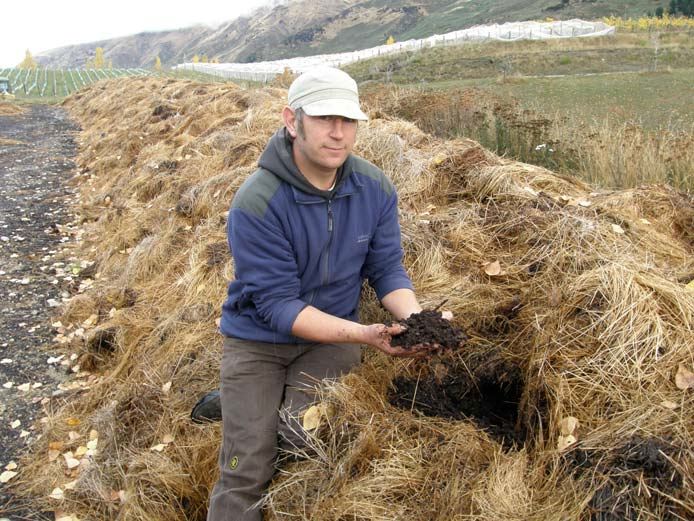 The early 1990s brought Rippon worldwide recognition and in 1992 the winery was awarded a trophy for New Zealand’s best red wine. Rippon’s success spawned a number of other successful wineries in the region, including Felton Road, Mt. Difficulty and Olssens, all of which were better funded than Rippon and attracted bright and well-trained winegrowers and winemakers. Gradually, Rippon lagged behind, the wines languished and Rolfe Mills passed away in 2000. It was young Nick Mills, Rolfe and Lois’ son, who guided Rippon back to the top. Nick Mills developed much of his fortitude and conviction competing as a champion snow skier on the slopes of New Zealand. Unfortunately, he blew out a knee just months before the 1984 Olympics. Disappointed and disillusioned, he traveled to France where he harbored fond childhood memories of trips spent with his father who traveled to learn about viticulture firsthand from the French. On these trips, Nick had picked up French, so when he returned, he was able to easily converse. He was fortunate to obtain a cellar rat position at Domaine Jean-Jacques Confuron in Burgundy and ended up staying in France from 1998 to 2002, studying enology and viticulture in Beaune and working in some of Burgundy’s most celebrated domaines including Nicolas Potel, de la Vougeraie, and de la Romanee-Conti. He never considered returning to New Zealand, and was thinking of traveling to Oregon when he received a phone call from his mother in 2002 asking him to come home and assume management of Rippon. He hesitated for a few months, and fortuitously eventually realized the potential of Rippon and what he could achieve with this marvelous property. Rippon’s vines are among the oldest in Central Otago, with some plantings dating to 1985-1991. 80% of the vineyard is planted on its own roots and is not irrigated. There are newer plantings as well. Pinot Noir comprises 40% of the 30 acres of plantings which are composed of Pommard, Lincoln, 10/2 and 10/5 clones. The vines at Rippon have always been farmed organically, but upon Nick’s return, the entire property was converted to biodynamie, a philosophy that Nick passionately adheres to. The Gaffneys with Rippon’s winery dog, Pipi the Ratbag and Rippon’s vineyard and Lake Wanaka in the background (2008).
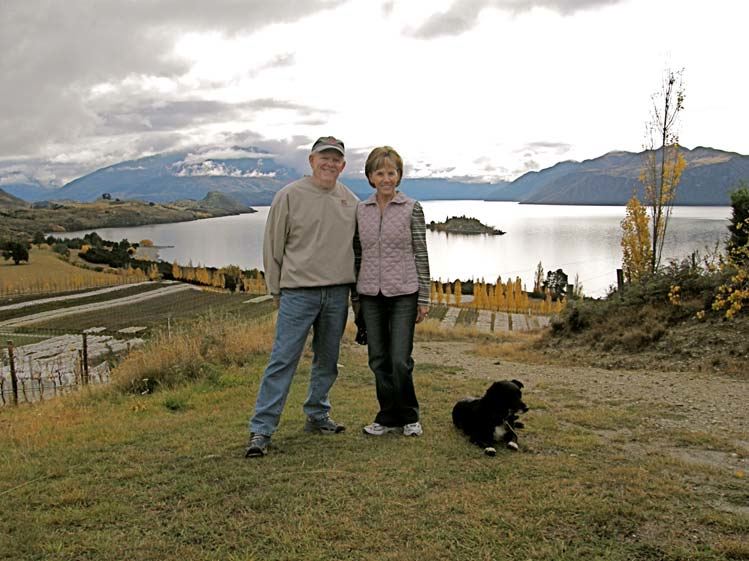 Different clones, vines of various ages and micro-sites within the vineyard are picked and vinified separately. Varying amounts of whole clusters are used. Natural yeasts drive fermentation which lasts 13 to 18 days. Most ferments are given extra time on the skins post fermentation making total skin contact time 15 to 28 days. The Pinot Noirs spend roughly 17 months in 22-35% new French oak barrels and are bottled unfined and unfiltered. The wines are then cellared. Until the 2008 vintage, a single Rippon Pinot Noir was produced. In 2008, four separate Pinot Noirs were crafted to better reflect the voice of the property. The Rippon Jeunesse Young Vine Pinot Noir is from grapes that are not considered mature enough to communicate fully all the complexities of the soils and site. It is a pure expression of Pinot Noir, a spirited voice of Pinot Noir grown at Rippon, rather than the voice of the land from which it came. The second bottling is the Rippon Mature Vine Pinot Noir made from fully developed Pinot Noir vines. Rippon Emma’s Block Mature Vine Pinot Noir is from a unique parcel within Rippon located on the lake front where ancient clay reefs run laterally through fine schist gravels. Emma’s block is named after the great-great-great grandmother of the current generation of the Mills family, through whom the name entered the family. The fourth wine, Rippon Tinker’s Field Pinot Noir is from another unique block within Rippon. This gentle, north facing slope was formed by an ancient ejection cone of coarse schist gravels. Tinker’s Field is home to the oldest vines on the property and is named after Rippon’s visionary founder, Rolfe Mills (Tink to his friends). Refer to the map below for the location of Emma’s and Tinker’s Field parcels.
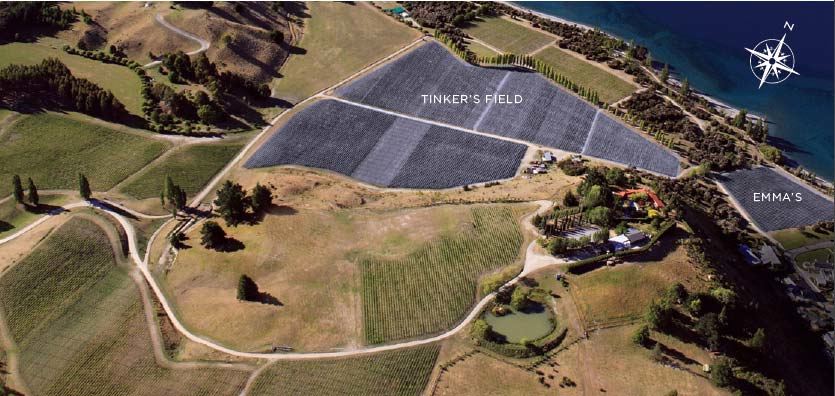 After sampling the 2008 Rippon Pinot Noirs, I was struck by the bright aromatics, the satiny textures and the highly nuanced flavor profiles. I asked Nick about these wines and how the fit the style of Rippon over the last 20 years. He replied as follows. “2008 was a very special vintage. It has what the French might express as de la séve (sap, but not really sappy). Its like juice, but not really juicy. It’s more like “flow.” It has all the detail and precision that we are used to from our coarse, schist-based soils, but the wine flows past these. The image of a stream might work here: normally a Rippon wine is a creek and if you were a leaf floating down it you would be getting caught in every eddy, hitting metamorphic rocks all the way down. In 2008, a full yielding year, we have more flow in the creek, so the rocks are still there, you just pass them faster and get caught less. The 2008 wines are a reflection of the vintage. Every vintage here is of course very different. It is just the nature of the site and the way in which we work to express that very clearly. It is interesting though that the last vintage which displayed somewhat similar characteristics to this, the very warm and fleshy 2006, sprung many peoples’ attention also. Like others, I absolutely adore these wines. I must say, though, the ones I find myself most drawn to, at least the ones on which I like to hang my hat (as it were), are often the more honed down, direct versions of the site. I love la séve, but I am perhaps prouder of the precise, layered detail and structure achieved in other years, for this is Rippon in its purist form: 1991, 1995, 2003, 2007.”
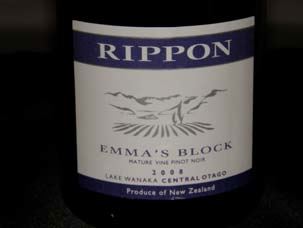 2008 Rippon Mature Vine Lake Wanaka Central Otago Pinot Noir 13.0% alc., pH 3.60, 1,989 cases, (224 cases USA allocation), $54, Diam. Released June 1, 2010. Clones 5, 6, 2/10, 10/5, 12, Lincoln. 27% whole clusters. Aged 10 months in 30% new to 4-year-old French oak barrels and aged over a second winter in neutral barrels (a total of 17 months in barrel). Unfined and unfiltered. · Charming aromas of dark stone fruits and berries, exotic woods and subtle oak spice. Moderately rich and mouth filling essence of dark grapes and berries with a hint of spice and minerals. Soft and satiny leaving a satisfying impression on the generous and lively finish. The most forward of the three 2008 Rippon Pinot Noirs tasted and quite showy for this vineyard. Very good (+).
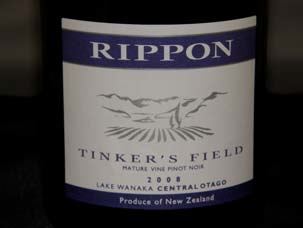 2008 Emma’s Block Mature Vine Lake Wanaka Central Otago Pinot Noir 13.0% alc., pH 3.60, 12 cases USA allocation, $74, Diam. Clones 5, 6, 13 and Lincoln. 23% whole clusters. Aged 10 months in 22% new to 4-year-old French oak barrels, then racked an aged a second winter in neutral barrels (a total of 17 months in barrel). Unfined and unfiltered. · Shy but very pleasing scent of dark fruits, dried rose petals and leather gathering intensity with time in the glass. Delicious mouthful of dark red cherries and berries. Very crisp and juicy with fine proportioned tannins and a silky follow through. Tremendous up side potential here.
 2008 Rippon Tinker’s Field Mature Vine Lake Wanaka Central Otago Pinot Noir 13.0% alc., pH 3.60, 12 cases USA allocation, $92, Diam. Clones 5, 6, 2/10, 10/5, 13 and Lincoln. 40% whole cluster. Aged 10 months in 35% new to 4-year-old French oak barrels. Racked after MLF and allowed a second winter in neutral barrels (a total of 17 months in barrel). Unfined and unfiltered. · This wine smells of the outdoors with scents of wooded forest, wet leaves, darkly colored berry jam and a hint of oak. Very tasty attack of dark cherry and berry fruit and cherry skins, all with a subtle earthiness. Moderately rich with fine-grain polished tannins, a welcoming tug of acidity, and impressive persistence on the bold finish. The wine glides across the palate with a dreamy silkiness. Hard to put this wine into words: suffice it to say you know it when you experience it. Great later in the day after opening. A New Zealand old vine Pinot Noir epiphany.
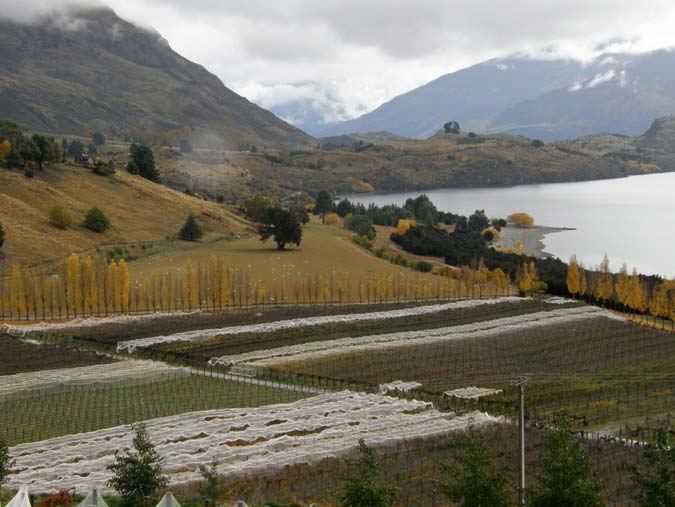 Rippon wines are imported by Penny and Andy Loving of Station Imports LLC in Colorado Springs, Colorado. They are frequent attendees at the major Pinot Noir events and very congenial people to know. Visit their website to purchase Rippon wines at www.stationimports.com. If you are planning a trip to Central Otago, you must visit Rippon for it is one of the most picturesque and most photographed vineyards in world.
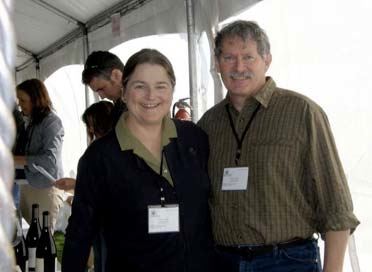
New Zealand’s Best PinotsTim Atkin MW reported on this year’s New Zealand Pinot Noir Conference in Wellington in The World of Fine Wine (Issue 27, 2010). He noted that New Zealand has emerged as one of the best alternatives to red Burgundy along with Oregon, California and Australia. Plantings of Pinot Noir in New Zealand have more than doubled to 11,920 acres and Pinot Noir is New Zealand’s most exported variety behind Sauvignon Blanc. Atkin noted, “New Zealand Pinots generally beat those from Burgundy for consistency, power, and fruit weight, but its wines still lag behind in complexity, longevity, and expression of place.” He went on to compile a list of New Zealand’s 25 world-class producers of Pinot Noir: Ata Rangi, Felton Road (several vintages reviewed in PinotFile), Seresin (recently reviewed), Neudorf, Pyramid Valley (see below), Pegasus Bay, Rippon (see previous feature), Schubert, Mount Edward, Julicher Estate, Martinborough Vineyards, Escarpment (previously reviewed), Bell Hill, churton, Bald Hills, Gibbston Valley, Craggy Range (previously reviewed), Mount Difficulty, Burnt Spur, Grasshopper Rock, Quartz Reef, Wooing Tree, Valli, Ma Maison, and Two Paddocks. I recently sampled two good Central Otago New Zealand Pinot Noirs, one of which was made by a producer who made Atkin's list.
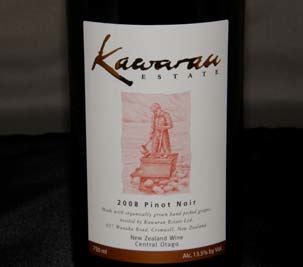 2008 Kawarau Estate Central Otago Pinot Noir 13.5% alc., $16, screw cap. Imported by Station Imports LLC, Colorado Springs, CO. From an family owned organically farmed vineyard. The label depicts identities from Central Otago’s gold mining era. Crafted by noted winemaker Dean Shaw at Central Otago Wine Company. · Complex aromatic profile of wild berries, rose tea, underbrush, savory spice, and oak. Light but pleasing core of cherries, cranberries and pomegranates with a slight confected note and a grapefruit peel infused finish. Crafted for current drinking. Good.
 2007 Pyramid Valley Vineyards Growers Collection Calvert Vineyard Central Otago Pinot Noir 13.5% alc., pH 3.71, 700 cases, $44, screw cap. Imported by multiple US importers including Wine Connections Inc, Denver, CO, Cellar Door Imports, Inc., Woodland Hills, CA, Robert Mackin, Artisan Wines, Norwalk, CT, and Terra Firma Wine Co, Oakland, CA. Pyramid Valley proprietors Mike and Claudia Weersin source grapes from prestigious growers throughout New Zealand. Calvert Vineyard is farmed biodynamically by the team at Felton Road. Unfined and unfiltered. · Deeply colored trending to the purple spectrum. Lovely black cherry and blackberry fruit aromas initially, fading some over time revealing a more savory spectrum of scents including underbrush, green garden and the slightest oak. The moderately dense red and black fruits have an earthy side and a presence on the palate that demands your attention. Juicy and silky textured with fine grain tannins and a clean finish, with a beautifully harmonious composition that can age. A metrosexual wine: fairly masculine intensity with a soft and elegant presence.
Along the Pinot TrailI was recently in Sonoma County, hosting two couples from McMinnville, Oregon, who won an “Russian River Valley Immersion Weekend” that I donated to last year’s Salud Oregon Wine Auction. The four (Lloyd and Linda Town and Bruce Morgan and Linda Levy) were hard core Willamette Valley Pinot Noir lovers who had never been in the Russian River Valley so it was quite an eye-opening experience for them. They left Portland on a day in which it was in the 50s and dreary, landing at Santa Rosa's Charles Schulz airport where they were greeted by blue skies and temperatures in the mid to high 70s. A brief summary of the weekend’s activities follows.
Convivial host Bob Mosby, the General Manager at Benovia, led the group through a lunch time tasting of Benovia wines. Benovia’s cottage, located on the estate’s property, was generously donated to house the group this weekend. Benovia’s owner, Joe Anderson, has provided the financial support to convert the original Merry Edwards facility into a state-of-the-art winery, resurrecting the existing adjacent vineyard and initiating extensive new plantings. Talented winemaker Mike Sullivan, who was hired away from Hartford Family Winery, is at the helm and the wines, beginning with the first releases in 2006, are superb. The lineup includes Pinot Noir, Chardonnay and Zinfandel. The wines are sold primarily through a mailing list at www.benoviawinery.com. The winery is open for tasting by appointment (707-526-4441).
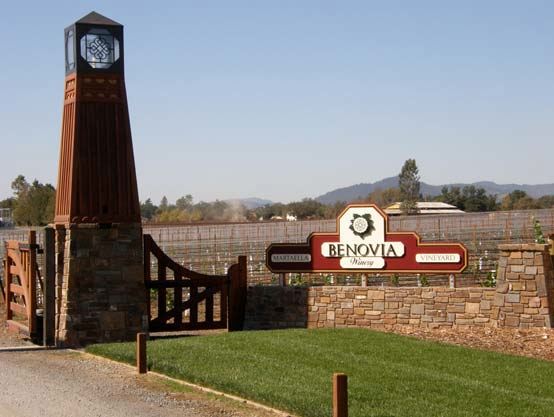
2008 Benovia Sonoma Mountain Chardonnay 125 cases, $35. From the Four Brothers Vineyard owned by Michael Sullivan and his brothers. Aged 14 months in 40% new French oak. · An upfront, charming wine with pleasing flavors of green apples, citrus fruits and baking spices. This was the first wine the group tasted upon arriving in the Russian River Valley, and they were stoked. Good.
2008 Benovia La Pommeraie Grass Valley Chardonnay 350 cases, $48. · A more serious wine from a vineyard planted on a former apple orchard farmed by George Martinelli. Bright and crisp with acidity of 3.25, this complex offering displays flavors of green apples, lemon curd, and minerality. Highly lauded by the wine press including myself. Very good.
2007 Benovia Savoy Vineyard Anderson Valley Pinot Noir 200+ cases, $55. · Really drinking beautifully now after some time in the bottle. Displaying that wonderful Savoy earthiness with rich dark fruits and savory herbs. Delicious.
2008 Benovia Sonoma Coast Pinot Noir About 1,000 cases, $45. Sourced from several vineyards. · A standard bearer for the winery which needs more time to evolve. The potential is obvious. Good.
2008 Benovia La Pommeraie Russian River Valley Pinot Noir A fall 2010 release and only bottled a few weeks prior so similar to a barrel sample. · Still in a little shock but man, this is great juice. Beautiful fruit core with a tangy citrus note on the fruit filled finish. Definitely look for this one upon release.
Lynmar Estate is the most idyllic wine country setting in Sebastopol with its modern contemporary architecture, extensive herb and flower gardens, a 42-acre estate vineyard, and welcoming places to sit indoors in the Hospitality Salon and outdoors surrounded by gently rolling hills. The onsite chef and congenial staff as well as an array of accommodating venues creates the perfect setting for culinary and wine experiences. The Pinot Noirs, Chardonnays and Rosé offered here are all top notch too boot.
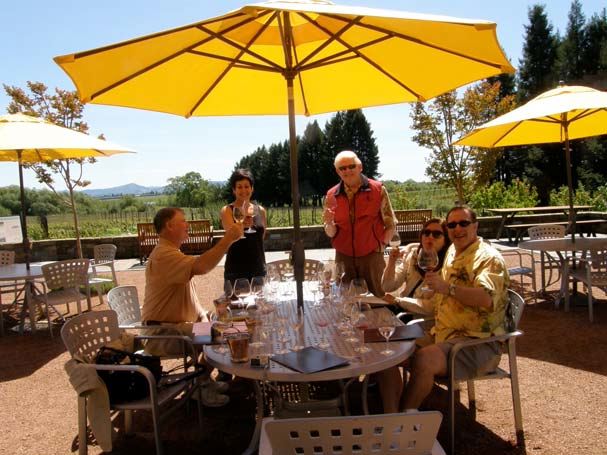 We were warmly greeted on a gorgeous morning and guided to our table outdoors for an extensive and instructive tasting. The co-proprietor and director of consumer sales, Anisya Fritz, is a charming woman who introduced herself and conversed at length with our group. The winemaker in recent years has been Hugh Chapelle but he has departed to pursue his own project and has been replaced by Bibiana González Rave. Rave is a native Colombian who pursued a degree in enology from the University of Bordeaux. She then chased harvests in France, California and South Africa. After 14 harvests and experience working in California at Peay Vineyards, Au Bon Climat and Qupe, she came to Lynmar Estate and assumed the winemaker duties in October 2009. Paul Hobbs continues as the consulting winemaker. Lynmar wines are sold online at www.lynmarwinery.com with some retail distribution of the larger production wines. The Hospitality Center at 3909 Frei Road is open daily.
2007 Lynmar Estate La Sereinite Russian River Valley Chardonnay 14.2% alc., pH 3.28, 658 cases, $70. Aged 14 months in 60 gallon French oak barrels (0% new). · A nod to Chablis. Shy aromatics with hints of tropical fruits taking some time to escape reduction. Delicious flavors of baked apples and crème brulee with an appealing crushed rock underpinning. Good.
2007 Lynmar Estate Quail Hill Vineyard Russian River Valley Chardonnay 14.3% alc., pH 3.38, 862 cases, $40. Aged 15 months in 45% new French oak barrels. 100% MLF. · Crisp and bright with aromas of lemon curd and green apple. Moderate density of apple and citrus flavors with a refreshing finish. Good.
2007 Lynmar Estate Wente Selection Russian River Valley Chardonnay 14.4% alc., pH 3.44, 880 cases, $35. Sourced from two small vineyards, mostly natural fermentation, aged in 45% new French oak barrels for 14 months 100% MLF. A one-time bottling as the fruit will no longer be available to Lynmar. · This was clearly the group’s favorite. Terrific nose featuring cut flowers, roasted nuts and spices. Rich and viscous on the palate with impressive persistence of the citrus and spicy notes on the bright finish. Very good.
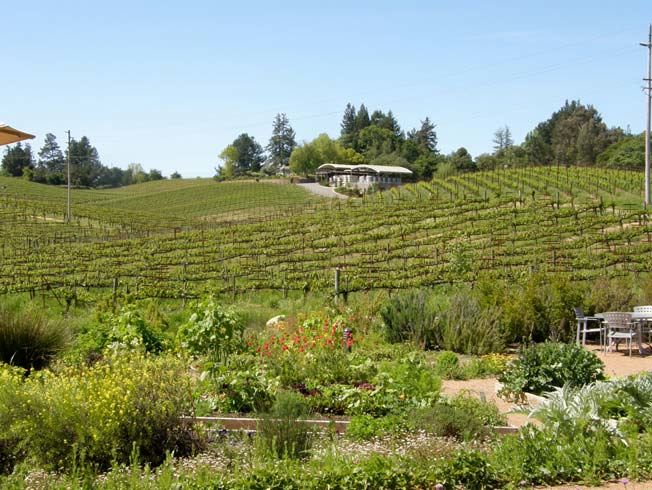
2007 Lynmar Estate Quail Hill Vineyard Russian River Valley Pinot Noir 14.4% alc., pH 3.63, 1,646 cases, $60. Only finest lots from the 47-acre estate Quail Hill Vineyard are included in this release with the core coming from a small block of old vine Swan selection planted in 1974 and a block of Dijon and Pommard clones. Aged 16 months in 60% new French oak barrels. Unfined and unfiltered. · A charming, delicate wine that seduces you with nuances. Lovely aromas of red fruits with hints of rose tea and baking spices. Discreetly concentrated core of red stone fruits and berries with a refreshing lift of aromatic fruit on the pleasing finish. Very good.
2007 Lynmar Estate Terra de Promissio Sonoma Coast Pinot Noir 14.4% alc., pH 3.67, 388 cases, $70. The Karen family farms 50 acres of Pinot Noir in Petaluma. Composed of 55% 777 and 45% 115. 100% destemmed, 7-10 day cold soak, native yeast fermentation, aged 14 months in 58% new French oak. · A wellstructured beauty with aromas and flavors of darker red and black berries, spice box, and exotic tea. Very smooth in the mouth with admirable finesse. Velvet glove over an iron fist comes to mind. Very good.
2007 Lynmar Estate Zephyr Farms Russian River Valley Pinot Noir 14.1% alc., pH 3.62, 569 cases, $70. Dijon clones planted in Goldridge soils at the western border of the Green Valley and Sonoma Coast appellations. Final blend is 50% 667, 25% 777 and 25% 115. 100% de-stemmed, 7-10 day cold soak, native yeast fermentation, aged 16 months in 70% new French oak barrels. · The aromatics are stunning featuring savory fruits and herbs. Picks up interest over the time in the glass, displaying a tasty array of red and black stone fruits and berries with an earthy and savory herbal underpinning. Still has tannins to shed and will benefit with additional time in the cellar. Very good.
Proprietor and winemaker Ted Lemon was returning from New Zealand on the day we visited, so assistant winemaker Trey Fletcher was nice enough to give us a tour and tasting. Lemon is a strong proponent of biodynamie and the photos below show the estate vineyard’s compost pile and the cow horns used in one of the preparations. In another photo below, Goldridge soil is demonstrated. This much talked about soil is found in large areas of the Russian River Valley and Grass Valley. This fine sandstone loam was created millions of years ago by collisions between the North American and Pacific tectonic plates and eruptions by volcanic vents that deposited volcanic ash over layers of eroded bedrock. Goldridge soils are particularly suitable to Pinot Noir and Chardonnay due to its low water retaining capacity.
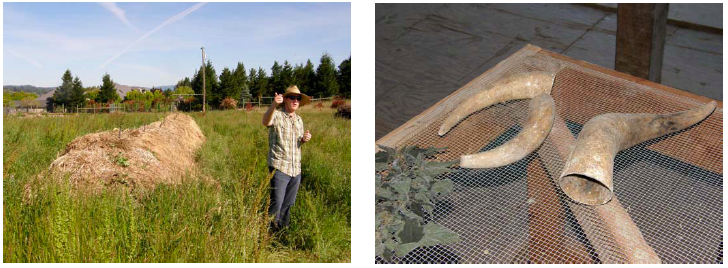
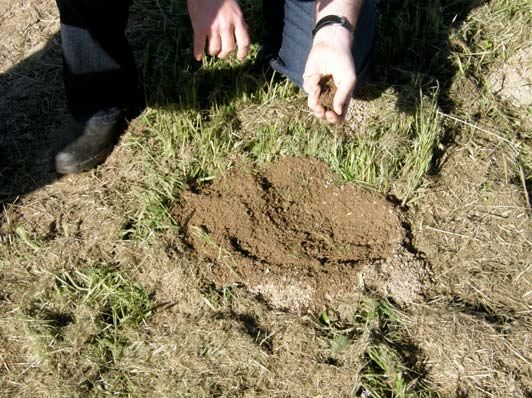 I did not take tasting notes on the wines sampled at Littorai since I wasn’t on duty. I have tasted the wines many, many times, and have never been disappointed. I was very impressed with the 2002 Littorai Thieriot Chardonnay and Pinot Noir and when I returned home after the trip, I rushed to my wine locker to see if I had any of these wines (Chardonnay no, Pinot Noir yes!). To be perfectly honest with you, Ted Lemon has crafted some of my greatest California Pinot Noir drinking experiences and I have tasted practically every Littorai Pinot Noir from every vintage dating back to the mid-90s. I have more Littorai Pinot Noir in my personal cellar than Pinot Noir from any other producer. When I see older vintages for sale, I snap them up because Littorai wines age extremely well (I have never tasted one that was “gone.”). Littorai wines are sold entirely through a mailing list, first come, first served, usually in lots of 3, 6 or 12 bottles of a single wine. A combination case composed of multiple wines is also offered. Visit the website at www.littorai.com for more information (Lemon is not big on marketing so the website is a bit sparse, but his annual newsletters are very informative), and to join the mailing list. A new winery opened on the Littorai estate in 2009 and tastings are now available by appointment by calling Sheri Wood at 707-823-9586. You owe it to yourself to visit at least once.
Many wine enthusiasts think of sparkling wine when they think of “J,” and the winery still does produce a magnificent lineup of sparklers. Since early 2006, however, J has embarked on a serious commitment to still varietals, most notably Pinot Noir. The winery’s vineyard holdings now encompass almost 300 acres of diverse hillside, bench land and valley floor plantings. George Bursick, the long time winemaker at Ferrari-Carano, was hired along with viticulturist John Erbe to transform J with less emphasis on sparkling wines and and more dedication to site-specific Pinot Noir. The 2007 vintage was the first that Bursick vinified completely and the results have been stunning. J was one of the first wineries in Sonoma County to offer food matched to wines tasted at the winery. The J Bubble Room is open Friday, Saturday and Sunday with seatings by reservation for a multi-course tasting of J wines matched with seasonal wine country fare prepared by onsite Executive Chef Mark E. Caldwell. Below is the menu we experienced when we visited. All the still wines we were served have been reviewed previously in the PinotFile. The upscale setting, the service, the wines, and the carefully thought out gourmet accompaniments make for a very sophisticated wine tasting experience. Visit the website at www.jwine.com for more information about other tastings offered at J Vineyards & Winery.
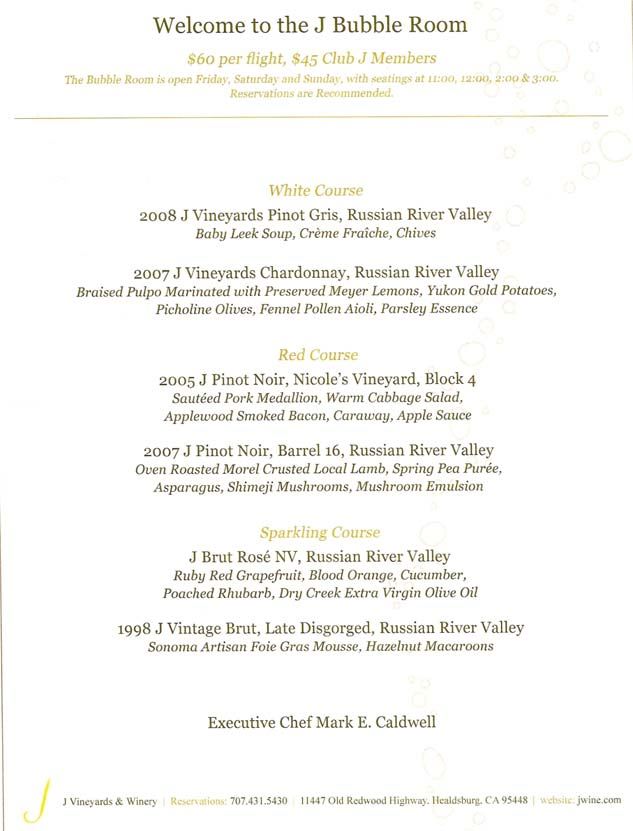
Benziger Family Winery: Commitment to Terroir-Driven Pinot Noir
Winemaker & Viticulturist Rodrigo Soto I was in the Russian River Valley in early May and the highlight of my trip was spending an afternoon with Rodrigo Soto, the Vice President of Winemaking at Benziger Family Winery. Soto, who joined Benziger in 2006, is spearheading the winery’s certified-sustainable farming program, and more specifically the certified organic and biodynamic Signaterra and de Coelo Pinot Noir labels. A graduate of the agronomy program at Chile’s Catholic University, he has extensive international winegrowing experience with biodynamic and organic wineries including his previous work at Matetic Vineyards with American consulting winemaker Ken Bernards in San Antonio, Chile. During his six-year tenure at the organically farmed Matetic, Soto’s wines won critical acclaim. Soto also has experience in New Zealand and at Fetzer Vineyards in California. Soto is on a mission to make wines that authentically reflect the terroir of Northern California’s expressive vineyards. He says, “We want Benziger wines to reflect the place where the grapes are grown. Benziger has made a commitment to decrease volume and increase quality and behind this is their dedication to natural farming.”
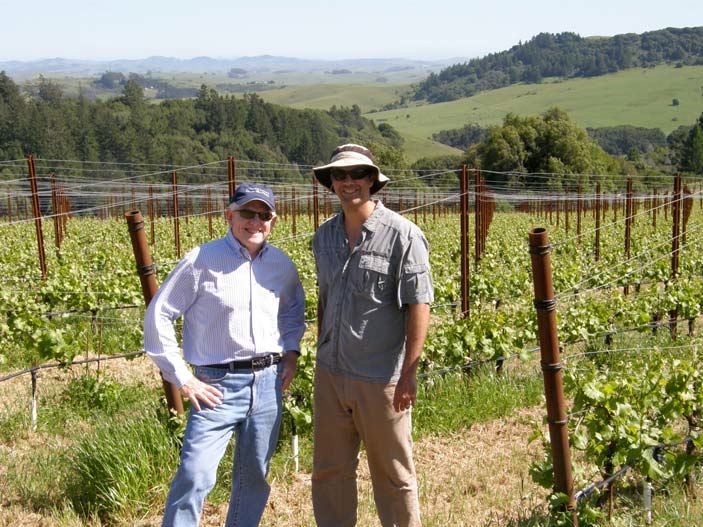 Soto and I walked the Benziger de Coelo estate on a glorious day in the true Sonoma Coast as you can see from the photo above. I cannot emphasize enough to the pinotphile that he or she must spend some quality time with a winegrower walking vineyards, kicking some dirt, spitting some seeds. Only then, can you truly appreciate the dedication involved in growing Pinot Noir and grasp an understanding of terroir. When I visit wineries, they can be surprised that I want to see the vineyards before I taste the wines. I believe that the place where a wine originated, not to mention the character and skill of the person who made it, is highly relevant to how that wine tastes and how it gives you enjoyment. de Coelo is a very cool growing site that is at the edge of where Pinot Noir will grow. On this afternoon, the temperature was well over 80 degrees, a rarity for early May. It has often been said that Pinot Noir thrives when it lives on the edge and this site is a perfect example. The vineyard is perched on a rugged hilltop about five miles inland from the Pacific Ocean where the rocky, shallow soils force the vines to struggle to produce diminutive yields. From the top of the vineyard, the vistas are magnificent with little sign of life except the neighboring Bodega Headlands Vineyard farmed by Kistler and sheep grazing in the distance. At this 20-acre, certified biodynamic vineyard, farming is directed at exposing every cluster to the precious sun available. The meticulous cane pruning is kept in a graceful arch to insure that each shoot is evenly composed and exposed (see photo below). Extensive thinning is employed during the growing season to insure only the highest quality grapes are harvested. Soto spends many days in this vineyard, visiting at least once a week, and by his estimate his crew tends to each vine by hand at least fourteen times before the grapes are harvested.
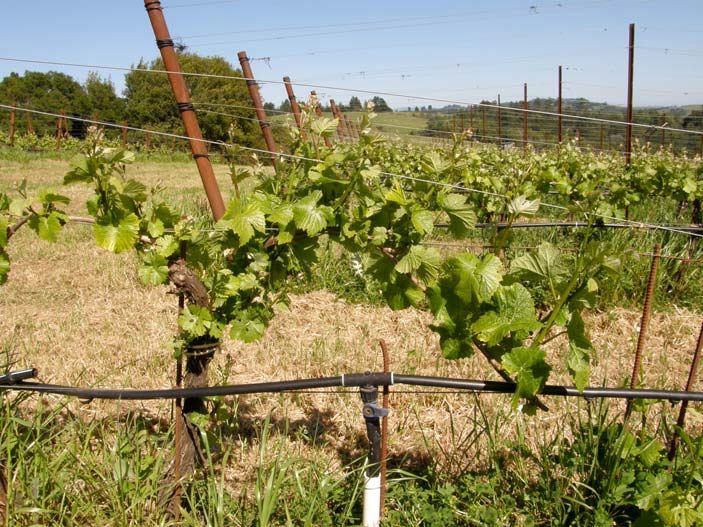 The vineyard is a project still in development. The lower 5-acre section, called Quintus, is planted to Dijon clones 667, 828 and a Swan selection. The upper steeper 10-acre section, named Terra Neuma, consists of Dijon clones 115 and 777. Here the soils are very thin, growth of the vines is more restrained, ripening occurs sooner, and the wines tend to be more intense. A distinct de Coelo Pinot Noir is made from these two parcels of the vineyard. Quintus spends 16 months in barrel, Terra Neuma 12 months in barrel which seems the best fit for the respective sites. A third, more exposed and windy site, consists of 5 acres of younger vines (clones 115, 777 and 828), and eventually is expected to provide a third wine from the property. We sampled the de Coelo Pinot Noirs at the vineyard under the shade of a large tree both before and after walking the vineyard and by the second pass, the wines had been opened for three hours. These are wines that demand your attention and contemplation. They are not flashy, fruity, flirty wines, but rather serious wines of the earth, full of intrigue and nuance that are worthy of their origin and can provide a unique drinking experience. Benziger touts them as more Old World or Burgundian in style than Caliesque, and I suppose that is a good fit, especially with their bright acidity and layered flavors. Soto’s winemaking is traditional using some whole cluster, indigenous yeast fermentations, and aging in 50% new French oak barrels. The wines are unfined and unfiltered. Production is about 500 to 600 cases of each de Coelo wine.
2008 de Coelo Quintus Sonoma Coast Pinot Noir 14.1% alc., Not released. · Initial: Sexy perfume of red cherries and cut flowers. Tight with oak showing. Later: Magnificent now showing an appealing earthiness enrobing the cherry fruit. The nose is bright with cherries and berries and the smell of bark, cigar box and the outdoor smell of underbrush. The dry fine grain tannins are restrained, and secondary notes of earthiness and grass have emerged. Very good.
 2008 de Coelo Terra Neuma Sonoma Coast Pinot Noir 13.5% alc., pH 3.38, 24 barrels, $69. 25% whole clusters. · Initially: Lighter in weight than the 2007 vintage. Fully ripe array of cherries and berries with an earthy underpinning and chalky tannins. Fruit and spice really shine with swirling. Later: Bright, sexy and aromatic now with riper flavors of soft berry fruit emerging. Intense and bold with the taste of the soil coming through on the finish. Very good.
 2007 de Coelo Quintus Sonoma Coast Pinot Noir 14.1% alc., pH 3.48, 19 barrels, $69 (sold out). Aged 18 months in 50% new French oak barrels. · Initially: More perfumed with brighter fruit. Lighter in weight with redder fruits including cherries and pomegranates. Soft in the mouth with a lively finish. Later: On the nose there are aromas of red fruits, vanilla and spice. Very tasty rich cherry core with a slight touch of tart cherry skins. Very good.
2007 de Coelo Terra Neuma Sonoma Coast Pinot Noir 14.4% alc., pH 3.56, 18 barrels, $69. Aged 10.5 months in 50% new medium toast French oak barrels. · Initially: Definite minerality on the nose. Flavors of dark fruits, anise, earth and a hint of citrus on the finish. Later: More finesse with flavors of dried cherries and red currants and a subtle underlying savory herbaceousnecss. Very good.
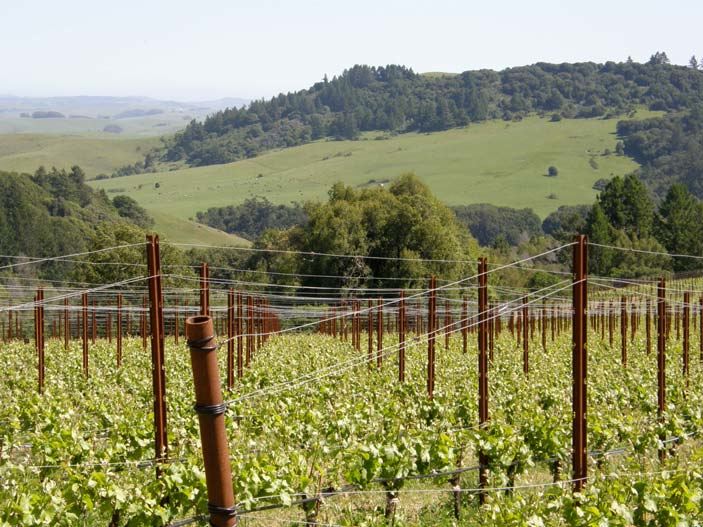 The Benziger Family Winery Pinot Noir program also includes the Signaterra wines which are premium vineyard designated varietals from Russian River Valley Vineyards farmed by the Benziger team (Bella Luna, San Remo, and Giusti vineyards). The 2007 vintages of the Signaterra Pinot Noirs were reviewed previously (www.princeofpinot.com/article/868/). These wines are also highly recommended. Visit the website at www.benziger.com to obtain the de Coelo and Signaterra wines. The Sonoma Mountain tasting room is open daily and special estate vineyard tours and tastings are available by appointment (707-935-4527).
Walter Hansel Winery & VineyardA reader alerted me to this producer in the Russian River Valley. I had not come across the winery’s Pinot Noirs and Chardonnays for some time because the winery does not participate in any of the showcase Pinot Noir events in California and Oregon (I love the quote from The Winehound about Walter Hansel, “Under the radar but never over the top.”). I had last tasted the 2003 vintage and found the Pinot Noirs rather austere in style. I felt it was time to revisit the wines with the highly touted 2007 vintage and I was very pleased that I did. Walter Hansel Winery & Vineyard has achieved a low-key but dedicated following for Burgundian-styled Chardonnays and Pinot Noirs from the Russian River Valley. Walter Hansel was a lifelong wine lover who first planted vineyards in 1978, just down the road from Kistler and Dehlinger. Stephen Hansel, Walter’s son, planted additional acres in the late 1980s, founded the winery in 1996, and made the winery’s first commercial vintage that year, releasing just 350 cases of Chardonnay and 70 cases of Pinot Noir. Additional vineyards and a new winemaking facility were added to the family’s estate in 1999. Stephen Hansel owns several automobile dealerships in Sonoma County, which allows him to indulge his passion for winegrowing. Stephen Hansel’s mentor was Tom Rochioli, who advised him in his early years of winemaking when he worked out of a garage. Today, the winery farms 75+ acres located at the southern tip of the Russian River Valley near the Sebastopol Hills. The estate vineyard is planted to five different French and California Pinot Noir clones and five Chardonnay clones with the oldest vines over 25 years old. The clones are planted in various vineyard blocks, and the resultant wines have subtle differences resulting from the interaction of soils and clones. The vineyard designated wines are clonal specific and the estate wines (non-vineyard designated) are a blend of many clones from a variety of vineyard locations. Walter Hansel Winery also farms 4 acres of a neighbor’s Sauvignon Blanc vineyard. All the wines are estate grown. The vineyard-designate wines are produced in quantities of 100 to 750 cases and the estate wines approximately 1,200 cases. Prices are reasonable considering the quality. All the Pinot Noirs produced vary to some degree in flavor, density, and acidity, but I found the winemaking impeccable in the 2007 wines. Every wine I tasted was singing in harmony. A savory vein runs through all the wines which are quite drinkable now. These are not opulent-styled Pinot Noirs meant for sipping, but rather sit-down, table wines meant for food. About 5,000 cases of Pinot Noir, 5,500 cases of Chardonnay and 1,500 cases of Sauvignon Blanc are produced annually. The Walter Hansel wines are available through an online order form that can be faxed to the winery. The wines are distributed to fine retail stores and restaurants in California. Winery tours and tastings are available by appointment (contact Stephen at 707-525-3614).
 2007 Walter Hansel Hansel Family Vineyards Cahill Lane Vineyard Russian River Valley Pinot Noir 14.4% alc., $36. · Patience is required and rewarded with the emergence of a rich dark red cherry and berry core on the nose and palate. The flavors have a slight confected tone and a hint of smoky oak lurks in the background. Soft tannins create a silky mouth feel and the dry finish is pleasingly fruity. Very good.
 2007 Walter Hansel Hansel Family Vineyards Cuvèe Alyce Russian River Valley Pinot Noir 14.6% alc., $36. · The enticing nose offers a cherries jubilee with a hint of seasoned oak. Delicious essence of dark red and black cherries and raspberries with savory herbs adding interest. Perfectly composed with gossamer tannins, vivid fruit, and balancing acidity. This is the one I want to dance with.
 2007 Walter Hansel Hansel Family Vineyards The North Slope Vineyard Russian River Valley Chardonnay 14.3% alc., $36. · Straw yellow color in the glass. Aromas of lemon curd, roasted nuts and a hint of toasted oak. Crisp and bright with layered flavors of white peaches, lemon zest, brown butter and a healthy dose of dusty oak. Slightly creamy in texture with a bright tug of acidity on the finish. Very good.
2007 Walter Hansel Hansel Family Vineyards The South Slope Vineyard Russian River Valley Pinot Noir 14.3% alc., $36. 100% clone 115. · This wine is showing plenty of oak toast and smoke on the nose. The dark berry core is tasty, with underpinnings of smoky oak and a hint of root beer, and the wine is balanced, but the oak overwhelms the experience. Decent.
 2007 Walter Hansel Hansel Family Vineyards The Three Rows Russian River Valley Pinot Noir 14.1% alc., $45. · Complex aromatic profile which develops nicely in the glass revealing scents of strawberry jam, Bing cherries, and cut flowers. Medium-weighted red cherry and berry core with notes of red currants, exotic tea, and savory herbs. A wine that aims to please with elegance and charm. Very good.
“Good Cheap Pinot Noir”As the wine drinking public has felt the sting of the economic recession, there has been more interest focused on trading down and buying value-priced wines. If you are a Pinot Noir lover, however, this is a daunting challenge. As writer Jordan MacKay remarked in Wine & Spirits (April 2009), “There are certain phrases that you rarely, if ever, hear in wine circles. One example is “good cheap Pinot Noir.” One producer that stands out in the value-priced Pinot Noir category is Verve, the wines of Aubin Cellars. Some of the Pinot Noirs have not only been good, but very good, and relatively cheap too. In the 2007 vintage, I reviewed three Verve Pinot Noirs from California and Oregon that were rated Very Good or Very Good (+), and priced from $24 to $33 (www.princeofpinot.com/winery/68/. Three more releases from the 2008 vintage can be recommended. Jerome Aubin is a wine barrel broker based in the Bay Area of California who imports barrels from Rousseau in Burgundy, Saint-Martin in Bordeaux, and Balazs in Hungary. In 2001 he started his own label with the assistance of noted winemaker Fred Scherrer who made the wines from 2001 until 2004. Subsequent vintages were crafted by winemaker Loren Tayerle. The word, “Verve,” refers to the energy or vitality in the expression of artistic ideas. Each label features a different work of a special artist. The wines are easily drinkable upon release. The wines are usually crafted in lots of less than 200 cases and the sources vary from vintage to vintage depending on Aubin’s resourcefulness in obtaining quality grapes. The wines are offered on the website at www.aubincellars.com along with some retail distribution.
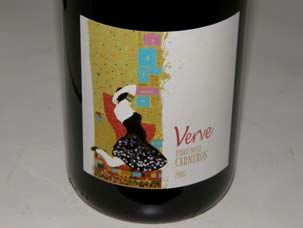 2007 Verve Carneros Pinot Noir 14.5% alc., 410 cases, $24. · Very complex aromatic profile featuring scents of wild berries, leather, wildflowers, herbs and even cream soda. Impressively smooth on the palate with a discreet arsenal of darker stone fruits and berries with a touch of hi-tone pomegranate. The oak is nicely integrated and the finish is well-endowed with fruit. Very good.
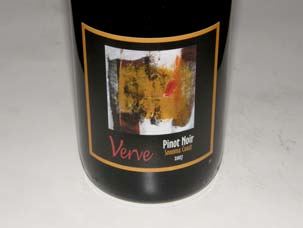 2007 Verve Sonoma Coast Pinot Noir 14.5% alc., 100 cases, $28. Released October 25, 2009.Clones 777 and Cruz. 100% de-stemmed, aged an average of 20 months in 25% new French oak barrels from Tonnellerie Rousseau. Bottled unfined and unfiltered and bottle aged 5 months. · An easygoing wine with pleasing aromas of cherries with hints of Herbs de Provence and seasoned oak. Highly enjoyable array of fruits including raspberries, strawberries and cherries with an earthy underpinning. Juicy with soft sinewy tannins and a vibrant finish. Nothing out of place. Very good.
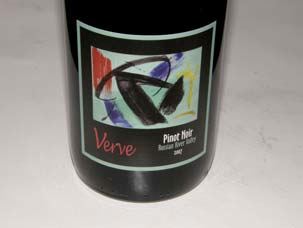 2007 Verve Russian River Valley Emeritus Vineyard Pinot Noir 14.5% alc., 214 cases, $33. Released October 25, 2009. From vines that average 8 years in age planted in sandy Goldridge soils. Clones 777 and Cruz. 100% destemmed, fermented in one Rousseau 2 ton French oak open top fermentor and T-Bins. Aged on average 20 months in 33% new French oak barrels from Tonnellerie Rousseau. Bottled unfined and unfiltered and bottle aged 5 months. · Darkly colored in the glass. Bright and clean scents of black cherries initially, showing a slightly roasted, raisiny quality over time. Moderately rich and very ripe Bing cherry fruit with hints of spice and savory herbs cruising to a crisp finish with a fine grip of acidity. Good.
Checking in with De La MontanyaDe La Montanya Estate Vineyards & Winery (DLM) is a bit off the beaten path from the more glamorous wineries on Westside Road in the Russian River Valley, but proprietor and winemaker Dennis De La Montanya has consistently produced exceptional Pinot Noirs from the Russian River Valley and Sonoma Coast appellations. DLM wines have won major awards at the Sonoma County Harvest Fair and San Francisco Chronicle Wine Competition. Dennis farms over 200 acres in Sonoma County and founded his winery in 2003. The barn-inspired winery and tasting room on Foreman Lane just three miles from Healdsburg (halfway between Armida and Twomey), houses one of the Russian River’s most eclectic lineup of wines. Dennis has the bit of the devil in him, and he is always crafting some new varietal or some variation on previous wines he has produced. Along with consulting winemaker Michael Loykasek, the small winery offers at least 30 different wines under the De La Montanya Estate, Felta Creek and Flying Rooster Red labels. DLM is one of the few wineries in California to offer a Pinot Meunier. A wide range of price points is offered. Adding spice to the lineup is a series of “Pin Up” wines featuring attractive women (fans of the winery) in pin up poses on the front label that are only sold at the winery. In addition, Dennis has a number of rock star friends and offers special charity bottlings in cooperation with rock legends such as the band Journey and Eddie Money.
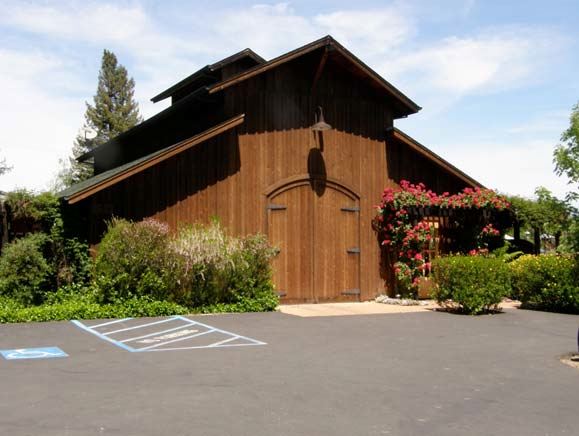 I stop in at De La Montanya periodically to taste and chat with Dennis and did so in early May this year. The wines were tasted at the winery right after opening and again later in the day from the opened bottles.
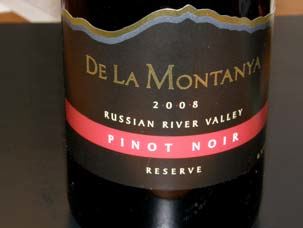 2008 De La Montanya Reserve Russian River Valley Pinot Noir 14.1% alc., 48 cases, Unreleased. Aged in 50% new French oak barrels. · This is a special wine which displays features of both the Tina’s and Christine’s bottlings. Both red and black fruits are evident with a perfect integration of oak. Delicately styled like the Tina’s, but showing more fruit and intensity and savory notes like Christine’s. The whole package is sensual and seductive.
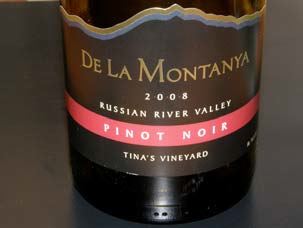 2008 De La Montanya Tina’s Vineyard Russian River Valley Pinot Noir 14.6% alc., 307 cases, $40. 75% Pommard and 25% Dijon clones. Aged 11 months in French oak barrels. · Light garnet color in the glass. Aromas of red cherries, berries, herbs and underbrush. Light on the palate but moderately intense in flavor featuring notes of strawberries, Bing cherries, baking spices and even a hint of red apple. A generally riper fruit profile than the 2007 vintage displaying a little warmth on the finish. Very good.
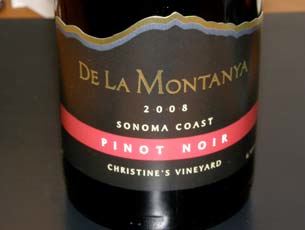 2008 De La Montanya Christine’s Vineyard Sonoma Coast Pinot Noir 14.4% alc., 47 cases, $45 · Moderate reddish-purple color in the glass. An appealingly fruity nose showing fresh dark stone fruits and a hint of herbal oak. Very taste essence of black cherries and plums with riffs of brown sugar, anise and oak wrapped in smooth tannins and finishing with a welcoming grip of acidity. Still young and needs to further integrate the oak, but Very good now.
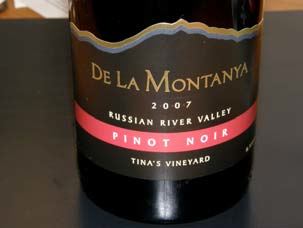 2007 De La Montanya Tina’s Vineyard Russian River Valley Pinot Noir 14.4% alc., $40. 75% Pommard and 25% Dijon clones. Aged 11 months in French oak barrels. · Delicately colored in the glass. The perfume is a dead ringer for a nicely spiced warm cherry pie. An elegant wine with juicy red fruits and gossamer tannins. Like drinking mother’s milk. Very good.
DLM wines are sold exclusively through the tasting room, to wine club members, and through the winery’s online store at www.dlmwine.com. The tasting room is open daily from 11:00 to 4:30 (by appointment weekdays). Dennis couldn’t get me taste his Tempranillo, but I did taste the DLM Ahh Late Harvest Botrytis Russian River Valley White Wine made from 82% Gewürztraminer and 18% Viognier (15% residual sugar, 14.7% alc., $45, 375 ml). This wine was a delight with its apple, pear and banana fritter medley of flavors and a sweetness that was not cloying. I took it home, kept it in the refrigerator corked, and enjoyed a few sips over the next several weeks.
Small Sips of California Pinot 2007 Beauregard Estate Grown Santa Cruz Mountains Pinot Noir 15.0% alc., 400 cases, $35. Aged 27 months in French and American oak barrels. From a family winery that has been farming vineyards in the Santa Cruz Mountains since 1949. Beauregard now farms over 100 acres. · Moderately dark reddish-purple color in the glass. Aromas of black cherries, raspberries, cassis, spice, and barbecue. Tasty juice with moderately intense flavors of dark cherries, berries and pomegranates with a hint of earthiness. Soft in the mouth with enough tannin and acidity to balance the alcohol. A husky wine that shows some charm. Good.
 2007 Beauregard Bald Mountain Vineyard Estate Grown Santa Cruz Mountains Pinot Noir 14.8% alc., 220 cases, $45. Aged 27 months in French and American oak barrels. · Moderately deep reddish-purple color in the glass. Darkly fruited on the nose and palate with some toasty oak in the background. Added notes of dark rose petals on the nose add interest. Restrained tannins and a pleasing core of fruit that has some persistence on the finish. An herbal oak flavor detracts. Good.
 2007 Beauregard Beauregard Ranch Vineyard Estate Grown Santa Cruz Mountains Pinot Noir 14.1% alc., 75 cases, Unreleased. Aged 27 months in French and American oak barrels. · Very shy, perfumed nose featuring dark fruits, forest floor, spice and cut flowers. Discreetly composed core of black cherry and berry fruit flavors with impeccable integration of oak. Well muscled and structured with fine grain tannins and a welcoming grip of acidity. Still a young and unevolved wine that has great potential. Very good.
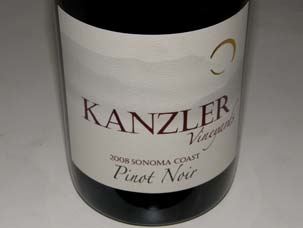 2008 Kanzler Vineyards Sonoma Coast Pinot Noir 14.8% alc., $48. Kanzler Vineyard is located in the coastal hills between Bodega Bay and Sebastopol and is farmed by Stephen and Linda Kanzler. The winemaker is Greg Stach. Aged 15 months in 30% new French oak barrels. Pommard and Dijon 115 and 667 clones. · Intense aromas of black raspberry coulees, cardamon and red roses. Delicious berry melange which is really a mouthful but there is an appealing roundness and litheness that tames the fruit. Light on its feet and velvety in the mouth, leaving a bit of warmth on the pleasing and persistent finish. Outstanding example of a hedonistic, lush style.
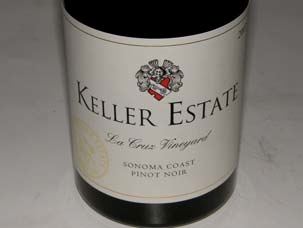 2007 Keller Estate La Cruz Vineyard Sonoma Coast Pinot Noir 14.1% alc., pH 3.49, 510 cases, $44. From the Petaluma Gap region of the Sonoma Coast. Harvested, vinified and bottled on site. Multiple clones including Pommard, Dijon 115, 123, 667, 777, 828 and Swan selection. The fruit was de-stemmed and fermentations were driven by native yeast. Only free-run wine was included. Aged 10 months in 35% new French oak barrels. · Marvelous nose with complex aromas including strawberries, raspberries, savory spice, and oak vanillin. A medium-bodied wine that is gentle and soft in the mouth with flavorful red cherry and berry fruits enhanced by loamy accents and a tangy finish of moderate length. Drinking perfectly now. Very good.
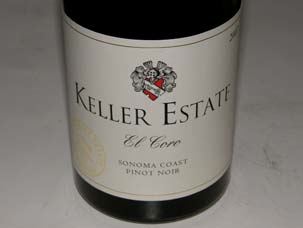 2007 Keller Estate El Coro Sonoma Coast Pinot Noir 14.1% alc., pH 3.45, 309 cases, $52. Released in December 2009. The inaugural El Coro bottling. the name “El Coro,” translates to “the choir” in Spanish and refers to a set of sandstone sculptures of a choir that sing at the foot of the vineyard. This 20-acre block is on a ridge top exposed to winds and has thin loamy and clay soil with a volcanic subsoil. Clones include Dijon 667, 777, 828, suitcase and Swan selections. · This is a more masculine expression of the Keller Estate. Lovely perfume of crushed berries, spiced plums, dark roses and tea. Darkly fruited with many layers of interesting flavors including notes of savory herbs, earth, minerals and citrus peel. Structured with ripe tannins and well balanced acidity. A more serious and more complex offering than the Estate bottling that will reward cellaring. Drink the Keller Estate Pinot Noir while this one gains in charm over time.
 2008 Morlet Family Vineyards Joli Coeur Sonoma Coast Pinot Noir 14.5% alc., $85. Sourced from the best section of the Coteaux Nobles hillside vineyard on the second ridge from the Pacific Ocean. The name refers to a beautiful (Joli) plot art the center of the ranch or its heart (Coeur). · Deep and intense aromas of black cherries, black raspberries and rose petals with a hint of smoke. Discreetly concentrated core of dark stone and berry fruits with an underlying mineral and smoky edge. The velvety texture is quite alluring. The smoky note tends to dissipate with time in the glass. Good.
 2008 Morlet Family Vineyards Coteaux Nobles Sonoma Coast Pinot Noir 14.5% alc., $75. · Deep reddish-purple color in the glass. Aromas of spiced plums, plum sauce, spice, sweet smoke and lacquered wood. Soft in the mouth with a moderately rich core of darker stone and berry fruits with a smoky edge. Beautifully crafted with very pretty fruit, but the smokiness, although tending to dissipate over time in the glass, spoils the experience. One bottle tasted was Decent. One bottle tasted was Good.
 2008 Morlet Family Vineyards En Famille Sonoma Coast Pinot Noir 14.5% alc., $85. This bottling is dedicated to grandparents, parents and relatives. · Moderately dark reddish-purple in the glass. Complex array of scents including black cherries, raspberries, spice fennel, redwood, smoke, ash and cigar box. The most delicate of the three bottlings with a demure sweet-fruited palate with a satiny mouth feel. Subtle flavors of smoke, tobacco and burnt rubber. Tasted twice. Decent.
Note: A well-known winemaker crafting Sonoma Coast Pinot Noir spoke to me about the smoke taint issue recently. He told me no one completely escaped smoke in the 2008 vintage on the North Coast. It all comes down to how the smoke affected the wines. Many producers have been reluctant to talk about it because any mention of it comes as an indictment of the wine and the winery that decided to release it. Some wine show elevated levels of smoke relative to clean years, but the result can be complimentary and contribute to the complexity of the wine. I feel that the 2008 Morlet Pinot Noirs have a subtle smoky edge which may be more apparent to a wine critic like myself. Some consumers may find the wines very enjoyable, especially those that prefer oak-derived flavors in wine.
2008 Thomas Fogarty Santa Cruz Mountains Pinot Noir 14.1% alc., pH 3.80, 1,593 cases, $29. 50% estate vineyard and 50% six other Santa Cruz Mountain vineyards. · Shy but pleasant aromas of berries, Herbs de Provence, and the slightest oak and mint. Flavors veer to the red/blue fruit spectrum including strawberries, cranberries and blueberries with a hint of herbs in the background. Balancing t n ‘a. A solid wine that will perform well at the dinner table. Good.
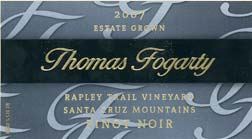 2007 Thomas Fogarty Rapley Trail Vineyard Estate Grown Santa Cruz Mountains Pinot Noir 14.5% alc., 125 cases, $48. The first Rapley Trail Pinot Noir since 2004. Aged in 43% new French oak barrels for 18 months and was bottled unfiltered. · Opens slowly in the glass, revealing shy scents of berry compote and oak. Vivid, fresh fruit saturates the palate showing red and black cherries and berries with a lingering berry and citrus tang on the finish. Terrific finesse and very soft in the mouth. A well structured and harmonious wine that is entirely seductive, but needs time for the aromatics to catch up to the flavors. Very good (+)
2008 Thomas Fogarty Rapley Trail Vineyard Block B Estate Grown Santa Cruz Mountains Pinot Noir 13.8% alc., <50 cases, $68. First B Block since 2004. Aged in 50% new French oak barrels and bottled unfiltered. · Very expressive aromas of wild berries, violets, brioche, graham and a hint of smoky oak. A delicious panoply of fruit flavors that really stick to your mouth. Dark red berries and strawberries in abundance with undertones of savory herbs and forest floor. Everything is proportioned and singing in harmony. This wine’s character supersedes the delicious fruit. Brilliantly crafted and flatout great. The impeccable balance predicts a long life ahead.
Note: At Thomas Fogarty winemakers Michael Martella and Nathan Kandler ferment all the Pinot Noirs in small lots, including between 25% and 50% whole clusters and using indigenous yeast fermentations. The press fraction is kept separate allowing a later decision on its inclusion. The wines are aged in 3-year air-dried French oak barrels. The Rapley Trail Vineyard was planted in 1981 and has long been the backbone of the “Estate Reserve” Pinot Noir. Beginning in 2002, portions of the vineyard have been bottled separately.
Seeing Red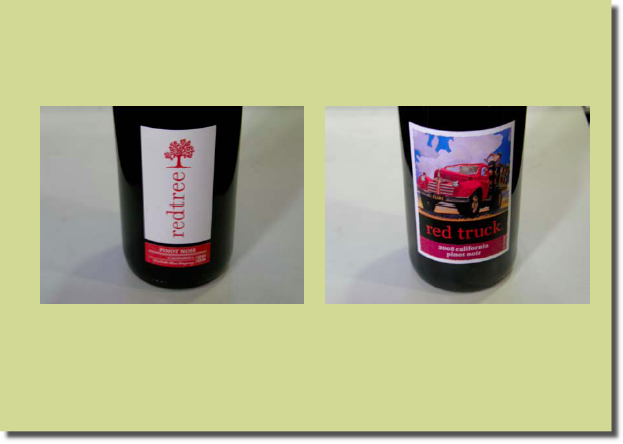 One of these two wines, the 2008 California Redtree Pinot Noir was a popular Pinot Noir last year after being touted by James Laube of the Wine Spectator, and the other, the 2008 California red truck Pinot Noir is a ubiquitous wine on super market wine department shelves. Both are priced at $7.99. I just had to try them. Redtree is produced by the Cacchetti Wine Company and the winemaker is the former winemaker for Pepperwood Grove, Bob Broman. Red truck comes from red truck winery in Sonoma owned by Fred and Nancy Cline of Cline Cellars. The winemaker is Charlie Tsegeletos, a University of California at Davis graduate who has been with Cline Cellars since 2002 and produces several varietals under the red truck moniker. These two Pinot Noirs are casual, back-porch wines that have their place. They are nicely packaged, fruit forward wines meant for early consumption.
2009 Redtree California Pinot Noir 12.5% alc., $7.99, screw cap. · Moderate reddish-purple color in the glass. Confected aromas of spiced red cherries and raspberries with some hints of underbrush. A fruity wine that reminds me of sangria with its slightly spicy citrusy and berry flavors. Medium-weighted and soft in the mouth with mild tannins, this wine actually improved over time in the glass. A surprise at this price. Decent.
2008 red truck California Pinot Noir 13.0% alc., 10,000 cases, $7.99. From vineyards in Monterey and “California’s Northern Interior.” · Moderate reddish-purple hue. Restrained aromas of dark stone fruits, wet earth and oak. Tasty core of dark fruits with a subtle oak accent. Pleasant and moderately light in weight and smooth in the mouth with soft tannins. I suspect this wine has more than Pinot Noir aboard, but what the heck, it tastes pretty good. Decent (+).
|